|
Ace Oliveira posted:That was the plane the replaced the AC-47, right? American soldiers in Vietnam called them Puff, the magic dragon. They were armed with three M134 miniguns. They were basically the percursor of the AC-130. They were way too vulnerable to ground fire, though. They were some pretty interesting aircraft. You should do a post about those fixed wing gunships. Hell, even the mighty AC-130 was used in Vietnam. The history is actually a bit more interesting than just a linear progression of AC-47-->AC-119-->AC-130. The AC-47 is the OG (original Nickname wise, gunships have some of the coolest...the AC-47 was first called "Spooky," also as you said "Puff, the Magic Dragon," the AC-119 was originally "Shadow," the later -K variant with the 20mm cannon and the jet engines was called "Stinger," and the AC-130 was first "Spectre," and is now "Spooky." Also, they had some seriously cool nose art...I have to jet to work, but I'll be sure to include some of the nose art when I do up the post.
|
|
|
|

|
| # ¿ May 10, 2024 22:28 |
|
mlmp08 posted:Here's a great couple of simulators. Defcon is pretty entertaining, although the whole "missile silos can be either offensive or defensive" thing annoyed me...I understand why they did it, and it probably improved the game, but it still annoys me. Also, the fact that bombers carried ballistic missiles disappointed me somewhat...I feel like they could've added cruise missiles without complicating things much and that this would've added quite a bit to the game, particularly if you were playing a Europe vs Russia scenario. That said, I was impressed that they included the ability to launch nuclear armed bombers from your carriers. So for unfilled requests, I have...Nosmo's nuclear strategy and tactics post, mlmp08's glide bomb post, the thrilling conclusion to my Skyraider/A-X/Warthog two parter, and a gunship write up.
|
|
|
|
themachine posted:I've been devouring his thread, because ever since I was a kid, all this stuff has fascinated me. I love all the crazy poo poo both sides did during the cold war, it never stops entertaining me. This may be sort of an ambiguous question, but I'd like to know more about nuclear weapons and carriers, specifically, what types they carried/carry, strategy, deployment methods, stuff like that. You mean, "what types they may or may not have carried/carry?"  The U.S. maintains a policy of deliberate ambiguity regarding whether or not it has nuclear weapons deployed at any one particular installation or vessel. I'm much better versed on the Air Force/aviation side of things, but I'll see what I can come up with regarding weapons and carriers.
|
|
|
|
McNally posted:Oh, aircraft carriers totally carried nukes. There was a Stephen Coonts novel about it once. Final Flight, second Grafton novel after Flight of the Intruder. Featured a generic third world Marxist Arab '80s action movie terrorist bad guy trying to steal the nukes on board a carrier. Despite that, it wasn't half bad...Coonts stuff went down after that, but those two were pretty good books. And carriers during the Cold War are kind of like the NATO nuclear sharing bases, where we acknowledge that we may have nuclear weapons in the abstract at these types of facilities/vessels, but we don't get into which specific installation/vessel has them. Of course, there are five foreign bases in various countries in NATO where we "just happen" to send a lot of U.S. 2W2 (nuclear maintenance) personnel, but I'm sure that is just a coincidence.
|
|
|
|
Craptacular posted:Battleships carried nukes too. But in true Navy nuclear related fun facts, the Navy had nuclear depth charges: 
|
|
|
|
Young Freud posted:You just know that that Bear will still be flying when the F-22 is mothballed. In rough chronological order of introduction to service:  USAF F-102 intercepting a Bear  RAF English Electric Lightning intercepting a Bear  USN F-4 intercepting a Bear  USAF F-106 intercepting a Bear  USN A-7 intercepting a Bear  USAF F-4 intercepting a Bear  British RAF Phantom intercepting a Bear  British RN Phantom intercepting a Bear  USN F-14 intercepting a Bear  USMC AV-8A Harrier intercepting a Bear (don't ask me the story behind this one, I have no idea, but it's definitely a little unusual.)  USAF F-15 intercepting a Bear  USAF F-16 intercepting a Bear...RNoAF Vipers (usually operating out of Bodø) also spent a lot of time intercepting Soviet aircraft as they came around the North Cape of Norway. 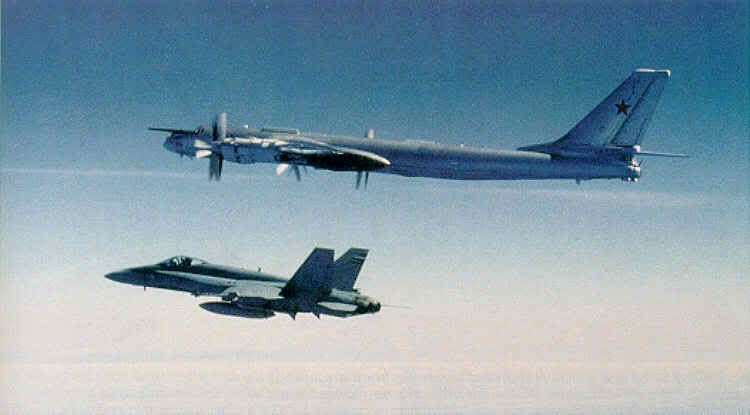 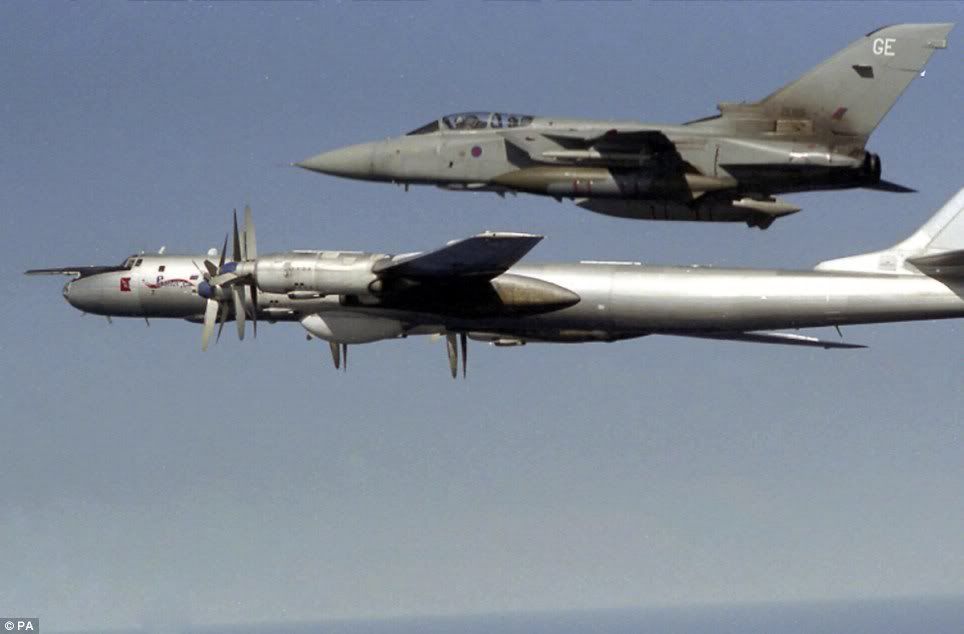 RAF Tornado ADV intercepting a Bear  RAF Eurofighter intercepting a Bear 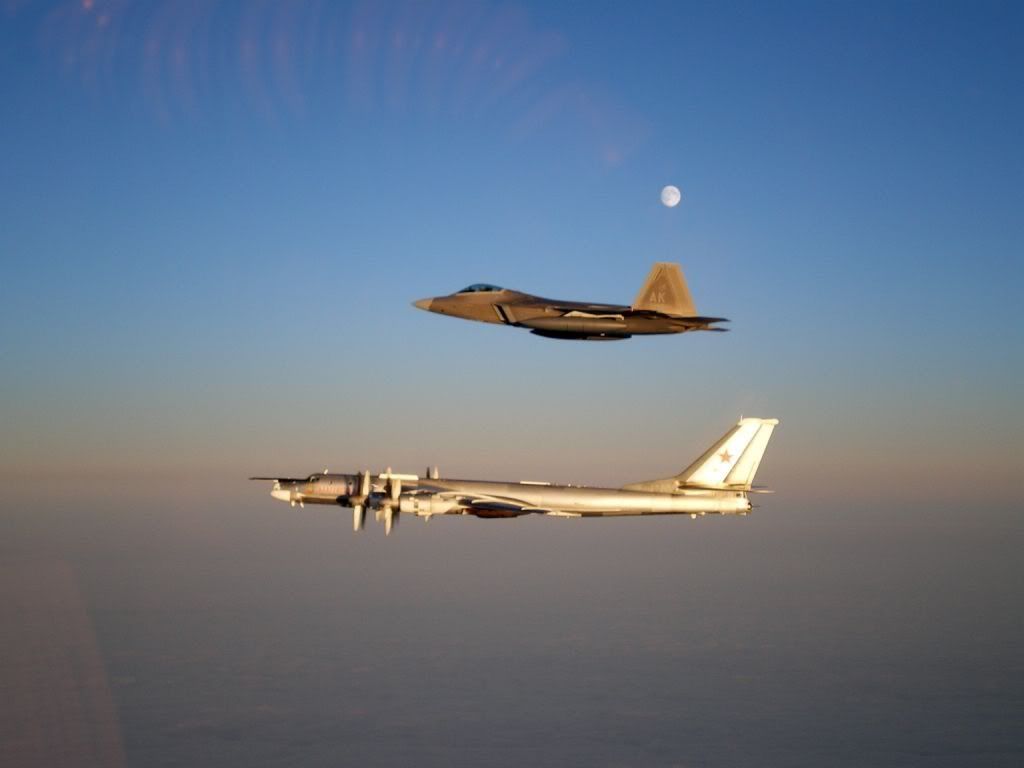 And finally, of course, USAF F-22 intercepting a Bear So yeah, I think your statement is probably going to be accurate. Just because I thought it was pretty cool, here's one more:  A USN F-14 operating out of Adak NAS and a USAF F-15 operating out of Elmendorf AFB (or one of its satellite airfields...probably either King Salmon or Galena) intercept a Bear. Not too often you see pictures of USAF and USN aircraft doing a joint intercept. And I highly discourage you from doing an imagine search for "bear escort," unless of course you are into that sort of thing. Suffice to say that only a few of the images returned featured Tu-95s...or any sort of aircraft. Also, Miso, that video dump was loving awesome. As an aside, one of the training videos I watched during my technical training for my Air Force job had some hilariously horrible stuff going on (like I said, I'm not a nuke troop, but I had to get some basic training in the career field)...awesome "shicka-shicka" '70s porn music, stilted senior officer "stare at the screen and read cue cards" narration, some horrible "acting"...basically like those NUWAX videos. However, ours also had a hilarious scene featuring a dude hauling rear end down a road with a "weapon" (obviously an inert trainer...I hope) on a forklift, hitting a bump, losing control of the forklift, and bailing, letting the vehicle continue to roll down the road with what was supposed to be a live weapon on board. Granted, we watched it half for the training value (it actually did a pretty good job of laying out the principles of nuclear maintenance and the stringent requirements regarding PRP) and half for the laughs, but still. iyaayas01 fucked around with this message at 04:20 on Jan 8, 2011 |
|
|
|
Flanker posted:CF-18 Hornet Sure enough. Also, I'm leaning more towards that F-16 being a RNoAF Viper, because I don't think the USAF ever used them in the interception role (that's why we had Eagles, after all), although they did give the Air Guard quite a few F-16s to be used in the air sovereignty mission, even going so far as to develop a specific "air defense" variant of the F-16 for the role. So I'm still on the fence.
|
|
|
|
VSEPR posted:Browsing youtube, I found a declassified video from what seems to be the early 1950's covering some of the planes in SAC and TAC, including the LABS maneuver. That was a pretty cool video...love the color footage from the '50s. Also, I've seen it before but I really like that picture of the Thuds and what I assume is an EB-66. I love the one silver painted Thud with all the rest camouflaged... And I haven't forgotten about doing up the nuclear tactics and strategy post, or part II of my A-10 saga, or the gunship post, or the glide bomb writeup, or my promised in another thread explosives safety write-up...the day job has been keeping me busy. Providing TOP COVER FOR NORTH AMERICA isn't easy, you know. Expect something this weekend. Fake edit: And nuclear weapons and aircraft carriers. Real edit: this video seems to be in the spirit of this thread - http://www.youtube.com/watch?v=yKYPellCiH8 25 or so minutes worth of silent (but color!) film regarding U.S. B-29 operations from the Marianas during WWII. Features, among other things, a cameo by the one and only Curtis E. LeMay. Well worth watching, the footage is very high quality. Also, if you haven't seen The Memphis Belle: A Story of a Flying Fortress (no, not the crappy Matthew Modine Hollywood version, the real deal) you're doing yourself a disservice: http://www.youtube.com/watch?v=UMDSFAYDV-Y All 41 minutes and 31 seconds of color WWII air combat footage from the USAAF's 8th Air Force, available for your viewing pleasure for free. Since I mentioned that, John Ford's Midway (again, the real deal, not the Henry Fonda Hollywood version) is also available: http://www.youtube.com/watch?v=7UiN-lNd_kY&feature=channel Color footage of THE pivotal battle in The Pacific and what was to the USN what Trafalgar is to the RN. Well worth watching. And since I mentioned THAT, you should also check out the video Ford made for the survivors of VT-8. If you are unfamiliar with the story of VT-8, the short-ish version is that they were a torpedo bombing squadron operating off of the USS Hornet at the Battle of Midway. They were mostly green pilots flying obsolescent TBD Devastators that were vastly outclassed by the Japanese air defenses. They were under no illusions as to what their chances were; during the brief their CO, LCDR John C. Waldron, gave them the following words: "If there is only one plane left to make a final run-in, I want that man to go in and get a hit. May God be with us all. Good luck, happy landings, and give 'em hell." Pressing home their attack without fighter cover, all 15 TBDs were shot down and only one of the 30 crewmembers survived. Additionally, a detachment of newer TBF torpedo bombers were operating from Midway itself; 5 of the 6 were shot down and only 2 of the 12 crew on that sortie survived. Put together that is a staggering 93% casualty rate. The squadron's sacrifice earned them the Presidential Unit Citation, the unit equivalent of the Distinguished Service Cross/Navy Cross/Air Force Cross. Following Midway, the squadron was reconstituted and saw battle around and on Guadalcanal, first on the Saratoga and then, after the Sara was damaged by a Japanese torpedo, operating from Henderson Field as part of the Cactus Air Force. While at Henderson Field VT-8 flew itself to the point of having no serviceable aircraft, earning another PUC in the process. The Squadron left the island in November and was disbanded. The video I'm talking about is something extra Ford put together for the families of the 29 TBD crewmembers KIA; it includes footage of them operating on and around the carrier, a few group shots of the whole squadron, close ups of each crew, and the memorial service held for them following the battle. The original, complete with honking WWII era heroic brass soundtrack, is here: http://www.youtube.com/watch?v=dL_2saZlNjQ However, I found this one to be particularly well done and more in the spirit of what the video is: http://www.youtube.com/watch?v=IsK1PeoMfNQ The soundtrack is unavailable now due to copyright issues, but it started off with this until about 1:15 in and then transitioned to this for the remainder of the video. Edit #2: Forgot to mention, there is a very well done in depth book on the history of VT-8 called "A Dawn Like Thunder." Covers the history of the squadron starting before the war and running through its disbandment following Guadalcanal. Also, since this is TFR, you'll notice that some of the pilots of VT-8 are carrying the M1911s in shoulder holsters...VT-8 was one of the, if not THE, first USN flying unit to be carrying them in shoulder holsters. Ens George "Tex" Gay (the sole survivor of the TBD sortie) was the one that started it, and it quickly spread throughout the Squadron and then throughout the ship. You'll also notice that a few of the guys are carrying a survival knife (Ka-Bar?) in addition to the shoulder holsters...they were the first on the Hornet to regularly carry that stuff. They got made fun of for it, but once the poo poo started hitting the fan everyone quickly started emulating them. iyaayas01 fucked around with this message at 10:10 on Jan 21, 2011 |
|
|
|
Mr. Despair posted:My guess is that they were just trying to see how unfeasible it was so that they had the data on file somewhere when a big wig decided to ask. Especially since it looks like someone just glued some LGB's onto the conformal cruise missiles in that picture. The LGBs I don't understand, as those aren't a standoff weapon, but the cruise missile kind of makes sense as a way to increase the F-117's combat load. You launch the cruise missile from a ways away and then punch the pylons to regain your low observable signature. Admittedly, that was probably a bit of a stretch for the first generation aircraft like the F-117, but the F-22 uses a similar concept for its external tanks...they use the tanks to extend their range and then punch tanks/pylons before entering the threat envelope of the enemy air defenses, going back to their normal LO state. There is (in theory) going to be the same thing on the JSF with the JASSM stealthy cruise missile...external carry with launch from far enough away to avoid detection, then jettisoning the pylons before coming within range of enemy radar. Scratch Monkey posted:When I was a kid I went to an air show that feature a JATO equipped C-130. Loudest loving thing I've ever heard. The Blue Angels' Fat Albert, more than likely. Sadly, they no longer do the JATO demo as they ran out of rockets.  
|
|
|
|
More video fun: Bit O' Lace - http://www.youtube.com/watch?v=krhi5qPld9Q Cool WWII color footage of 8th Air Force bomber operations. "Wing to Wing" - http://www.youtube.com/watch?v=k05RhUYinxM&feature=channel Great shots of RAF aircraft from the late '40s/early '50s, including some "Washingtons" (B-29s) wearing RAF colours. RAF Fighter Tactics Against the B-29: http://www.youtube.com/watch?v=-dMog3T3CAc&feature=related The fact that the Soviet Tu-4 (revealed a year before this video) was a carbon copy of the B-29 was a coincidence, I'm sure. Nuclear War Alert Simulation - http://www.youtube.com/watch?v=PkPbz53u1Ds&feature=related Interesting look at what SAC's procedures were like in the pre-ICBM era. I was chuckling a bit at the "How much time do we have? About two and a half hours" exchange. NF-5 landing on Autobahn - http://www.youtube.com/watch?v=hQPuRr2_MFg Exactly what it sounds like, the related videos include a variety of other NATO aircraft doing the same thing, including some relatively heavy ones (F-4s, for example). High Flight - http://www.youtube.com/watch?v=eTms_G1yYPc Good color footage of the F-104 Rocket sled ejection seat tests - http://www.youtube.com/watch?v=Dgq4Ejp9BnM&feature=channel Features dummies being hurled off cliffs at supersonic speeds. Landing at Kai-Tek - http://www.youtube.com/watch?v=OtnL4KYVtDE Crosswinds? What are those? C-130 report - http://www.youtube.com/watch?v=Abe-WmCGwgs Interesting video on the first production C-130s from 1955...those early -A models without the extended radome look goofy as hell. Takeoff, Drop, Land - http://www.youtube.com/watch?v=tq_beR0Yr3A Brand spankin' new C-130J flies an airdrop mission out of Kandahar. Check out the glass cockpit and the HUDs. FAC supports Army troops - http://www.youtube.com/watch?v=6QjMb9RKH1o Interesting footage of a Bird Dog FAC in Vietnam Fini flight of the F-15 up here at Elmendorf - http://www.youtube.com/watch?v=qOlPldvSx2E Pretty cool footage of flying around Alaska...know there were more than a few damp eyes when the last one left for good later that week. Pretty sure they had to restrain a couple of the crew chiefs that were watching to prevent them from running out and grabbing on to the landing gear as the jet taxied for takeoff. F-4E air defense scramble - http://www.youtube.com/watch?v=9fqBXqb6LP8&feature=related 5 minute alert (from horn to wheels up) in West Germany during the Cold War. F-22 airshow demo - http://www.youtube.com/watch?v=eFM8FHR56PY Having seen this demo in person, I can say that it is just as impressive as it looks. Of course, the most impressive thing about that aircraft is that if it ever has to use anything that was shown in that demo, it is having a REALLY bad day. 1967 Paris Airshow - Fashions of the Air - http://www.youtube.com/watch?v=uwLAU0QD6cI Some of those demo team maneuvers...holy poo poo, looks like the term "energy toward the crowd" hadn't been coined yet in 1967. NADGE Part I - http://www.youtube.com/watch?v=kT3B4ETlZnU&playnext=1&list=PL1B6605F807A7F44D&index=1 NADGE Part II - http://www.youtube.com/watch?v=UW5h03LwqPQ&feature=related ALL OF EUROPE IS WORKING TOGETHER TO ENSURE COLLECTIVE AIR DEFENSE--LET ME HIT YOU OVER THE HEAD WITH THAT POINT EVEN HARDER, BECAUSE THE VIDEO HITS IT PRETTY HARD. WHY AM I YELLING? BECAUSE THE SOUNDTRACK TO THESE VIDEOS IS SO loving LOUD THAT YOU WOULDN'T BE ABLE TO HEAR ME OTHERWISE. (Seriously, the soundtrack is loving ridiculous...they're worth watching for that alone. James Bond brass and some sweet rock guitars for some reason.) The Indispensables - http://www.youtube.com/watch?v=0_H5f16rM8U Features the phrase "this old bird" being used to refer to a KC-135...in a video that was filmed during the Vietnam War. William Tell Competition - http://www.youtube.com/watch?v=qw74Oy1gM94&feature=channel Features F-4s, F-106s, and some Canuck F-101s. Six turnin' and four burnin' - http://www.youtube.com/watch?v=3wvEzhyY9F4&feature=related If you haven't watched the movie "Strategic Air Command," you are missing out. The Strength of SAC - http://www.youtube.com/watch?v=LbZWyKxLvZY&feature=channel Considering it was produced in 1966, this is a pretty good realistic look at the SAC of the time. Also, I think "vicious sentry dogs" (on the warning sign outside the alert facility) has a much better ring to it than "military working dogs." The bit at the end about how the men of SAC were human reminded me of the old joke, "To err is human, to forgive is not SAC policy." TAC on Target - http://www.youtube.com/watch?v=egeEkbcZ3ow&feature=channel In keeping with its fighter pilot nature, the TAC video is quite flashy and showy compared to the SAC quiet professionals. It features, among many other stupid things, using the F-104 in a ground attack role and the F-105 in the air superiority role, and the GAR-8 AIM-9 missile and the F-110 F-4 fighter. Both were weapons originally designed by the Navy and adopted by the AF, but god forbid we call it the same thing. Oh, and those C-130E models that it mentions are just starting to enter service in 1962? Yeah, some of them are still in active service with the USAF. USAF staff report from 1979 - http://www.youtube.com/watch?v=IzmxTkWrWNk&feature=channel Includes features on the A-10, Cobra Dane radar, GBU-15, MX, F-16, NAVSTAR GPS, E-4, Space Shuttle, E-3 AWACS, F-15. It definitely feels like a blast from the past to see A-10s and F-16s releasing large amounts of dumb ordnance given just how ubiquitous PGMs have become. I'm pretty sure that whenever an F-16 loads up with a bunch of bombs, John Boyd rolls over in his grave. As far as NAVSTAR goes, it's amazing to me just how prescient the voiceover in the video was. Usually when you're viewing stuff like this 30 years on you can point and laugh at some of the stuff they predicted would come true, but with GPS is all came true and then some. I think what's probably most striking is that with the exception of the MX, all of these systems are still in active service today, 30+ years later. Planar wing LORAN guided GBU-15 - http://www.youtube.com/watch?v=lJr0iof48w4 More on that planar wing GBU-15 that never was...apparently it was also supposed to use LORAN as a sort of proto-GPS guidance system, something I had never heard of being used in a weapon before. I got most of these from two channels - http://www.youtube.com/user/jaglavaksoldier http://www.youtube.com/user/airboyd Both are well worth checking out as they've got a trove of military/aviation related videos.
|
|
|
|
mlmp08 posted:Well, there goes my morning. That F-22 video really shows off some pretty cool low-speed maneuverability. Also, those bastards look huge. Two of them flew over our motorpool and while I know in my head that they are virtually the same size as the F-15 they always strike me as just looking big. Having seen both of them up close in person, I think this perception of being bigger comes from a few things. Number one, the fuselage is canted outwards for LO and to provide room for weapons bays as opposed to the slabsides of the F-15. While it's still roughly the same size, being canted out will give the appearance of being larger, especially when combined with number two, which is that the F-22 has a considerably larger wing area than the F-15 (a couple hundred square feet more), which is going to make it look bigger even if the overall length/wingspan/ dimensions are similar. Here's a cool picture: 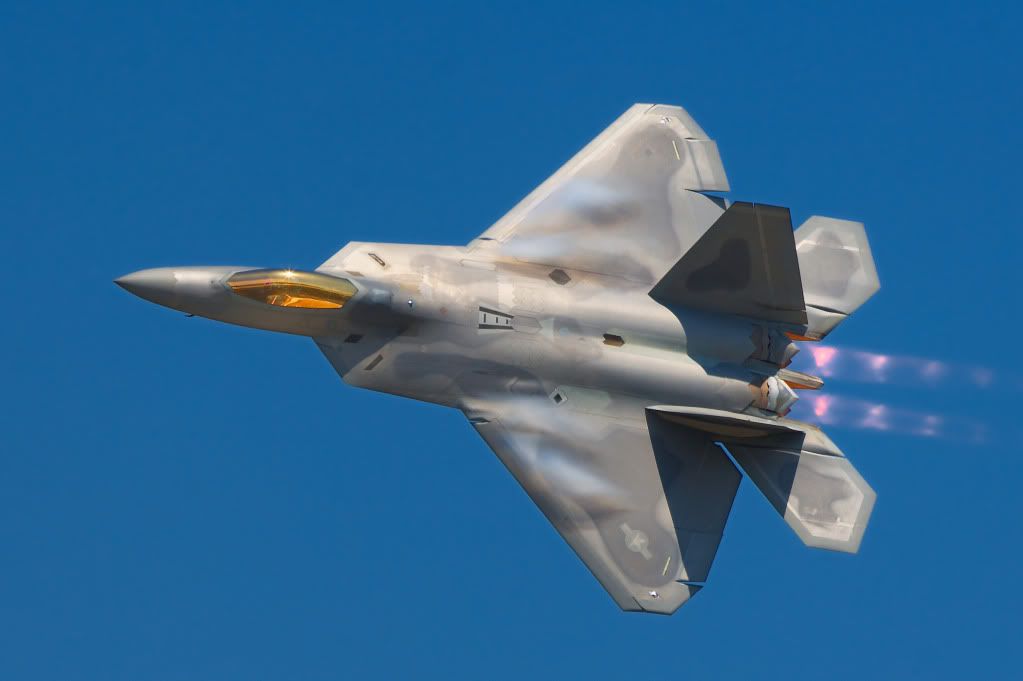 Sunday Punch posted:
Nah, it's not on fire yet.  Nice pictures, the B-36 is a pretty cool aircraft. Edit: iyaayas01 posted:More video fun: Hahahaha, holy poo poo, I hadn't finished watching this one yesterday, and even if you don't watch the whole thing you need to forward till about halfway through (~8 minute mark). There's a dude that must be TFR's granddad, because he's got like three shoulder holsters and two thigh holsters all rigged up in the most comedy ridiculous way possible; the shoulder holsters have a couple of bigass revolvers and a M1911, the thigh holsters are carrying some sort of combat knife, I think. Anyway, it's pretty funny. iyaayas01 fucked around with this message at 23:23 on Jan 23, 2011 |
|
|
|
McNally posted:Well, the 'stache thing wasn't specific to Olds. I know a guy named Ed Rasimus who flew F-105s in '65-'66, well before Robin Olds went to Ubon. After his first real mission up north, Rasimus' boss ordered him to grow a mustache. "It's a fighter pilot tradition," he said. "Makes you bullet proof." Okay, BESIDES the fact that he name dropped flying out of Ubon when Olds was the wing commander. And that's a pretty good story...aren't Rasmius's memoirs (When Thunder Rolled and Palace Cobra) supposed to be pretty good? I haven't had a chance to read them yet, but I've heard good things.
|
|
|
|
I like turtles posted:Someone needs to come with me on this tour: http://www.titanmissilemuseum.org/view.php?pg=10 That is awesome as hell. Looks like I now have a reason to go to AZ. I think I mentioned this before, but there is a National Monument in SD outside of Rapid City that is the same sort of thing with a Minuteman complex. It's not nearly as in depth, but they have an LF (silo), the above ground LCF, and the below ground LCC (control capsule), all preserved. On an unrelated note, I'm glad that this thread has been chugging along slowly but surely without me as of late. I will try (emphasis on try) to get the finale of my Skyraider/A-X/A-10 post up tonight.
|
|
|
|
djdanno13 posted:I think it was probably equal parts of combloc arms logistics. There were East German AK47's. The main difference, like basically all combloc ak's from different nations were things like pistol grips and flash hiders. The other side is probably the result of a dictatorship posing as communism discouraging private citizens from owning firearms. Really, when you think about it the only Warsaw Pact country that went out on a limb when it came to weapons designs were the Czechs...everyone else was just making variations on the Soviet pattern weapons (even something like the AMD 65 is just an AKM with some goofy furniture). Here's the link to the national park services website on the monument: http://www.nps.gov/mimi/faqs.htm And here are the directions: http://www.nps.gov/mimi/planyourvisit/directions.htm The visitor contact station (where tours start) is right off of exit 131 on I-90...right by Badlands National Park if you want a point of reference. Since you mentioned you go to Rapid all the time, have you been to the aviation museum there? It's right outside one of the gates onto Ellsworth and it's well worth visiting. A lot of cool airplanes and some interesting ICBM stuff as well.
|
|
|
|
Cyrano4747 posted:You really have to look at their respective WW2 era experiences for this. In both cases the people who were commanding the armies through the cold war were officers in WW2. Hell, I think the last WW2 vet command rank officers didn't retire from the US military until the 80s or so, although most of those guys were junior officers when they first saw combat. "If the airplane is silver, it's American. If it's camouflaged, it's British. If it's invisible, it's German."  But yeah, the degree to which the U.S. has enjoyed air superiority since WWII has been staggering. The last time American forces have even been attacked from the air period was Korea (no, TBMs don't count). Not trying to suck my own service's dick here, but seriously, the absolute dominance of the past 20 years has really been something. You could also draw a related but opposite conclusion regarding the role of armor...the M60 that U.S. personnel were still using into the 1990s could trace its lineage all the way back to the WWII era M26. mlmp08 posted:You see the same thing in Air Defense TTPs, particularly post-Cold War. When Patriot was designed during the Cold War, it was intended to have automatic engagement mode available and weapons control volumes (big 3d space of air) which were at Weapons Free (shoot everything not positively identified as a friend.) The system would be set to automatic when a horde of aircraft came flooding out of the Warsaw Pact and the operators would be there to manage system faults, ensure launchers were reloaded, and to interrupt or terminate engagements against any unidentified friendly craft. Tell me to gently caress off if the answer is sensitive, but who do you usually talk to on the AF side? Do you talk much with the guys that are airborne in an AWACS or is it just with someone on the ground in an AOC?
|
|
|
|
Senor Science posted:Oh man, that Su-25 is one sexy beast! Not really... Also, Mexico operates Mi-8/17s and a couple of An-32s, Nicaragua also operates Mi-8/17s along with a few An-26s, and Peru operates MiG-29s, Su-22s, Su-25s, Mi-8/17s, and some An-32s. And holy poo poo, that Su-25 write up was awesome. e: gently caress, reading comprehension.
|
|
|
|
U.S. military has had issues as well with some of its aircraft gun ammunition; specifically, 20mm for the M61. I won't comment directly since I've got professional knowledge of the issue and don't want to say something I shouldn't, but here's what wikipedia had to say:wikipedia posted:Ammunition
|
|
|
|
B4Ctom1 posted:from here: As for the rest of it, the issue was simply the U.S. had no need for it. Our teen series aircraft were (until the very end of the Cold War when MiG-29s and Flankers began showing up) far superior technology wise to the Soviets, and that combined with AWACS gave a drat near unbeatable advantage. Of course, there's the old joke, "Two Soviet generals meet in Paris, one asks the other, 'by the way, who won the air war?'" But yeah, "swarm" tactics like the ones you described only work when you have halfway decent aircraft and well trained crews. The one area where the U.S. did have a need for it was with bomber interception, which is why the earliest IRST were on interceptors like the F-101 and F-102, and why the only teen series fighter to have an IRST on board was the Tomcat, with a primary mission of being a long range bomber/cruise missile destroyer. Raw_Beef posted:This thread is great. Keep doing the weapons and vehicles write ups, ill keep reading. Holy gently caress, I need to play this. Propagandalf posted:We do have it. And don't forget, the Air Force cut JHMCS from the F-22 (our badass AIR DOMINANCE FIGHTER) because of money, the idea being since we don't have enough money for the whole fighter fleet we would bootstrap the older Eagles (which we'll still be using for quite a while, albeit in limited numbers) so they're not as hopelessly outclassed. So our newest, highest performance fighter doesn't even have a basic helmet mounted sight. Same justification and end result with the AIM-9X, although there are plans to get them on the newest batch of Raptors...although they won't be able to use the missile effectively (high off boresight launches) without a HMS. So, yeah. Alaan posted:Did F-14s actually have a big rear end camera they could slave to that or was Clancy making poo poo up in Red Storm Rising? Yup: http://www.ausairpower.net/TE-EO-Systems.html (Yeah, yeah, it's APA, I know). Skip down to the part about TISEO on the F-14 (just do a ctrl+f for "tiseo"). You'll see that they had that, they had IRST on the F-14s, they even had some jets that had a combined TISEO/IRST system.
|
|
|
|
This thread will riiiiissssseeeeee.... No time to do a long post because of the whole "being on the front lines of the Korean War" thing  , but here are some sweet RAAF pictures: , but here are some sweet RAAF pictures:About the coolest a P-3 will ever look: 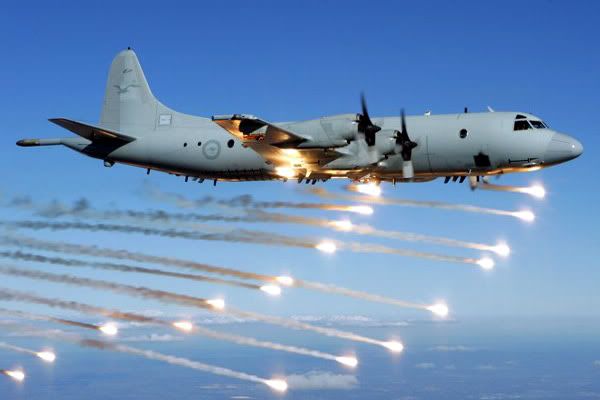 Now you see me: 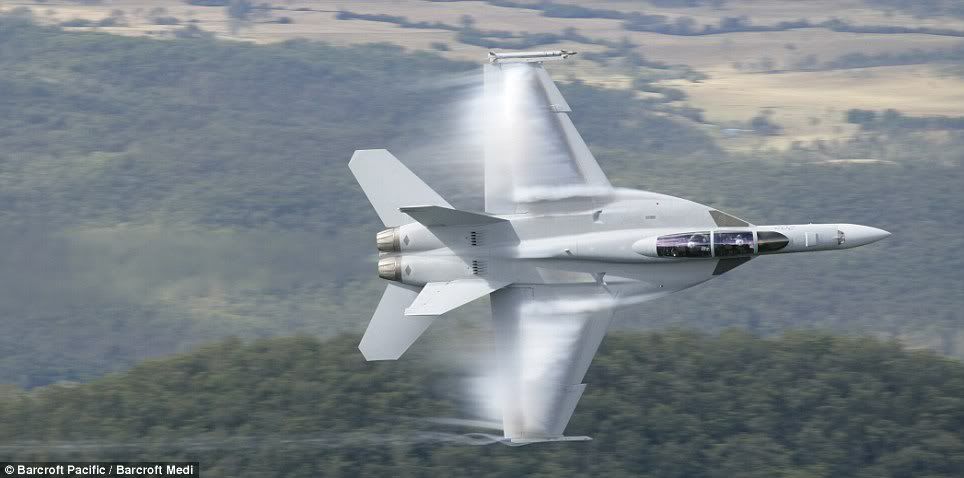 Now you don't: 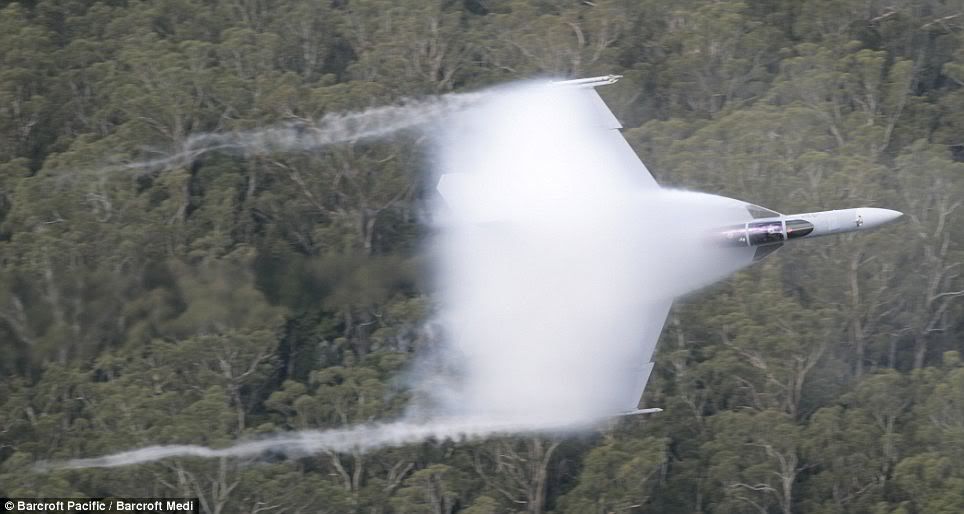 RAAF used to fly some French aircraft as well: 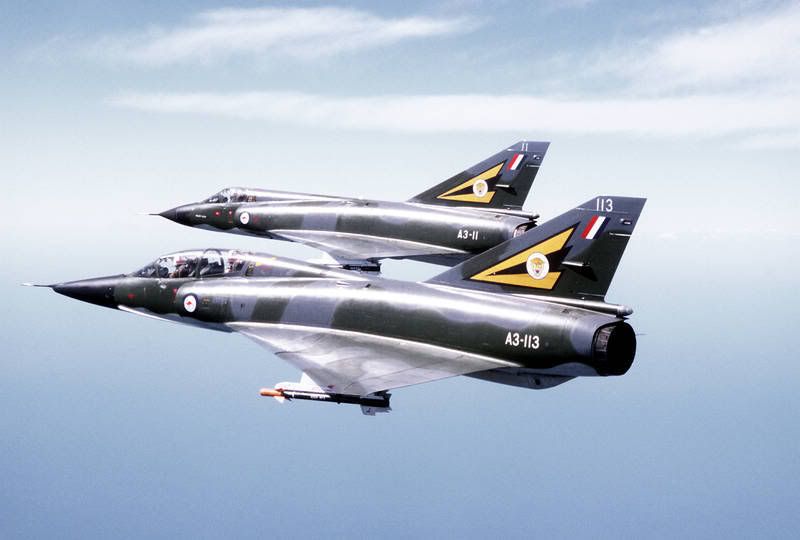  CARIBOU! 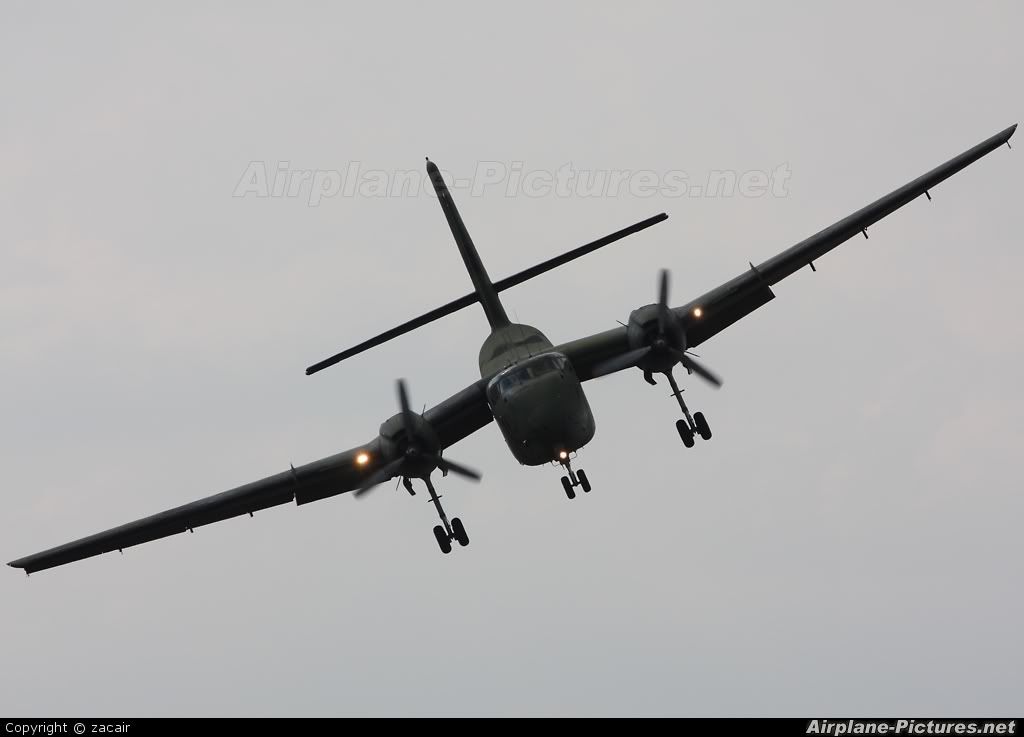 Cool series of pics:   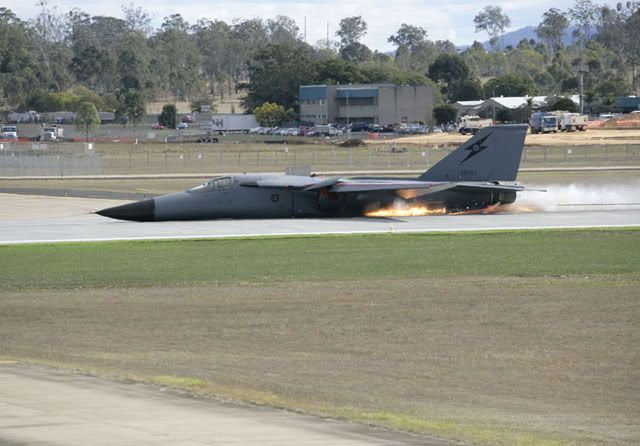 Farewell sweet prince 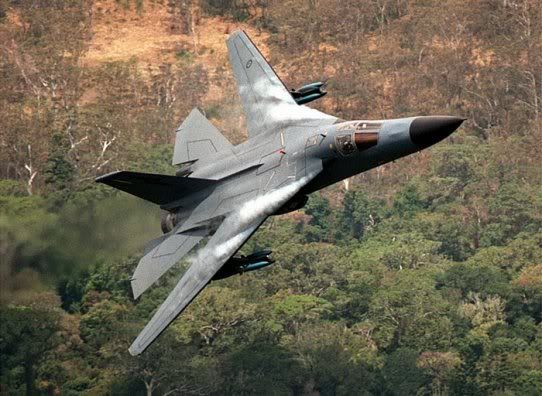 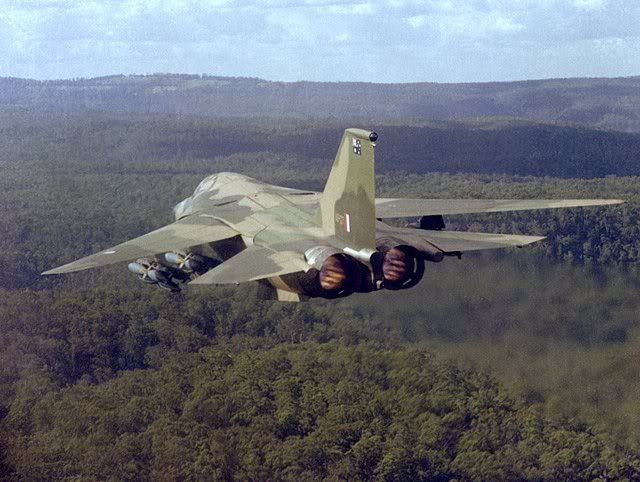
|
|
|
|
NosmoKing posted:I still think the F-111 and other swing-wing aircraft look cool as hell. Do you now? Little bit of Soviet/Russian (and Indian) action: 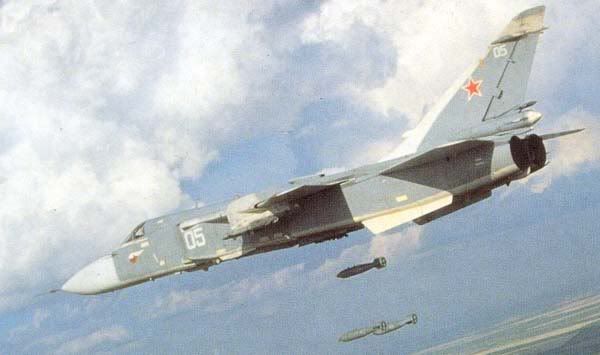 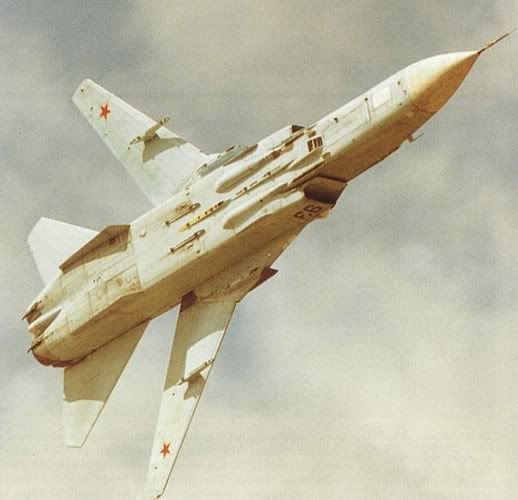 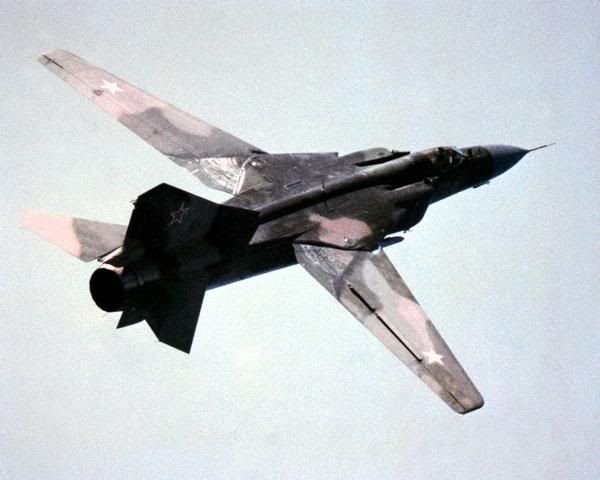 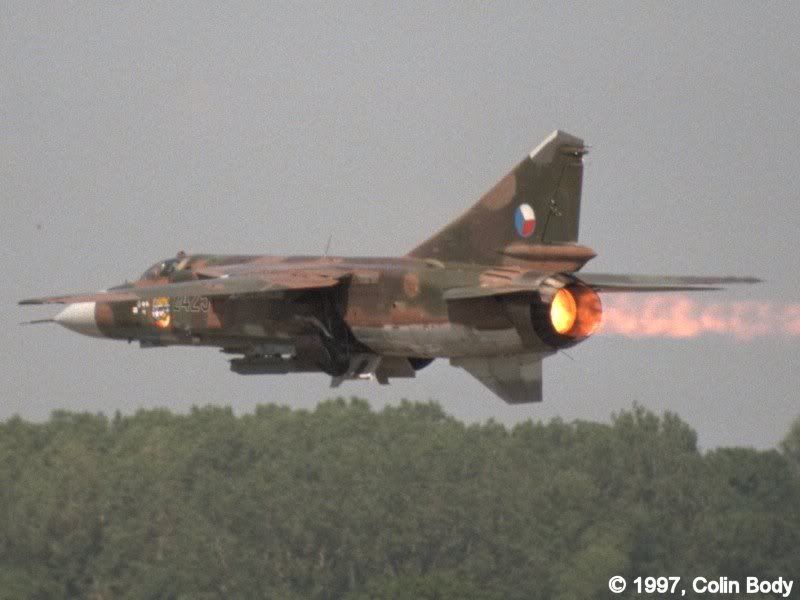 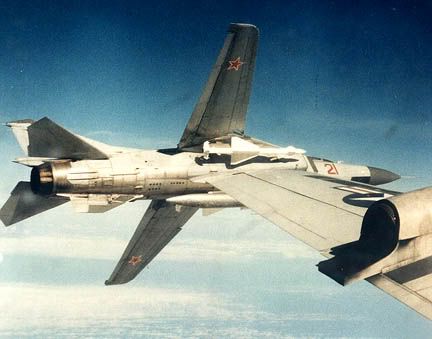 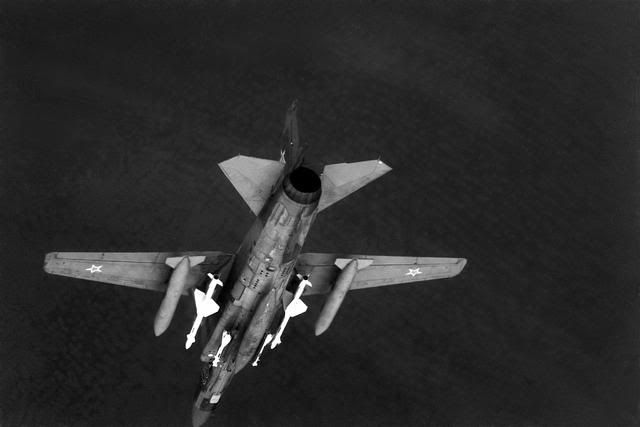 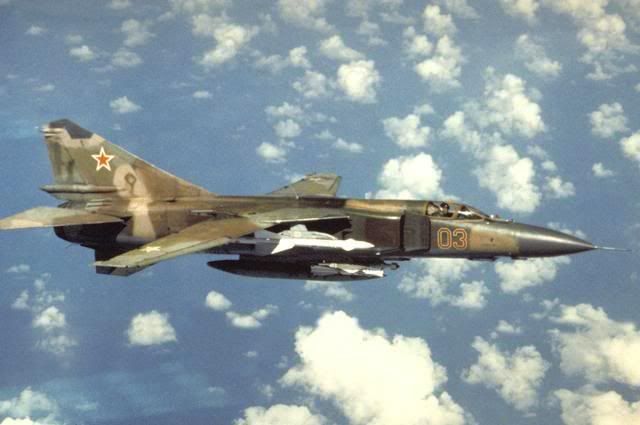 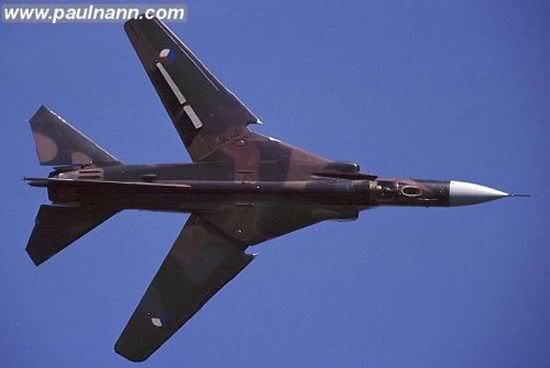  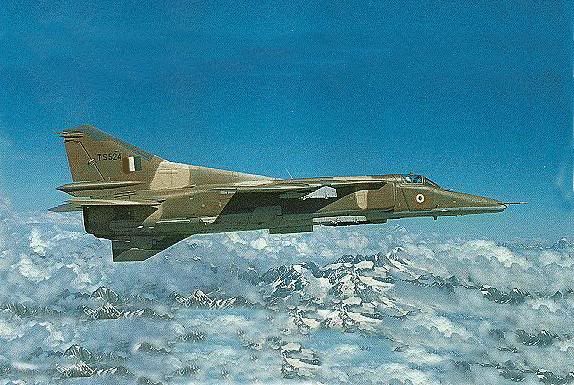 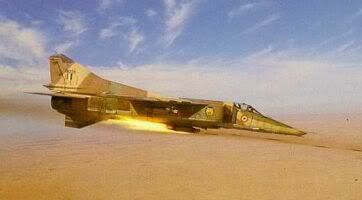 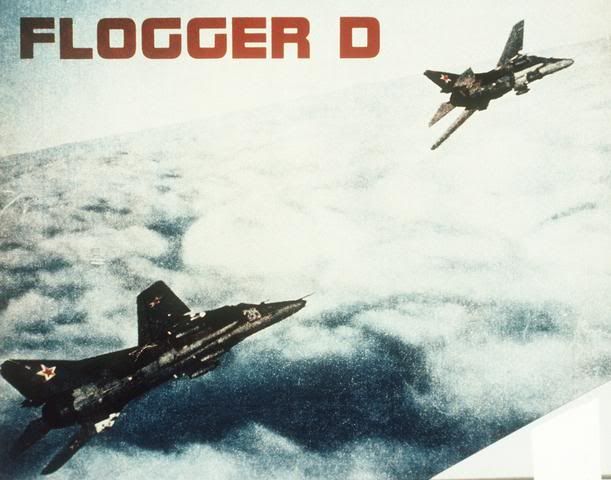 Cue up the Kenny Loggins...I feel the need... 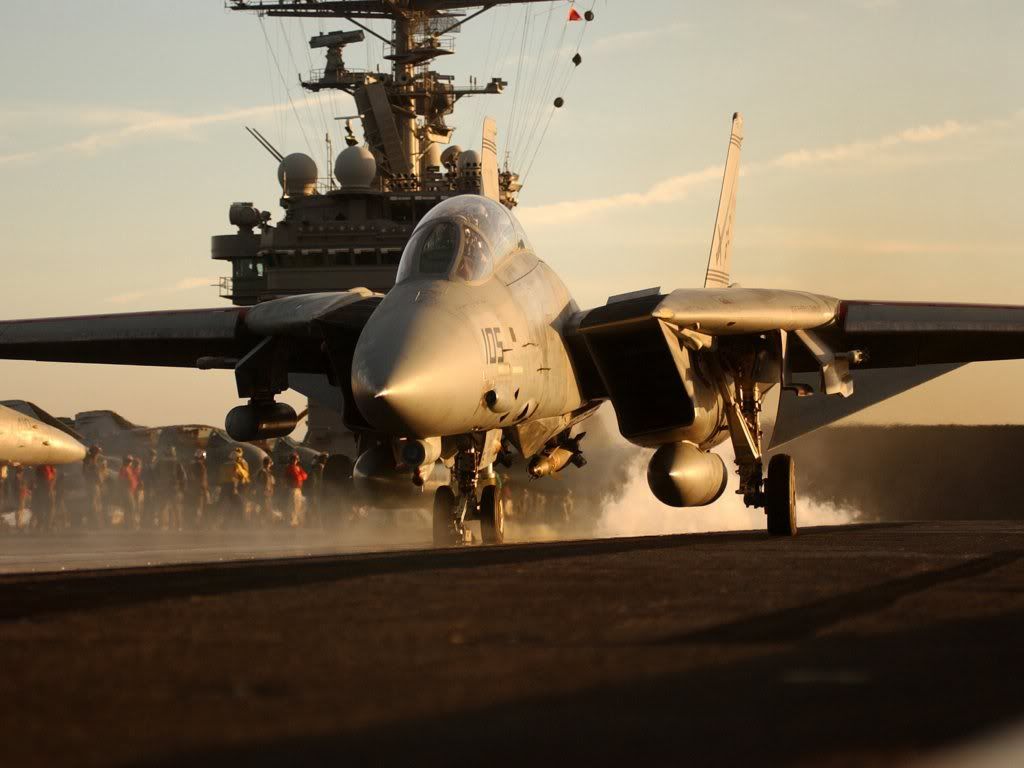 The need for speed 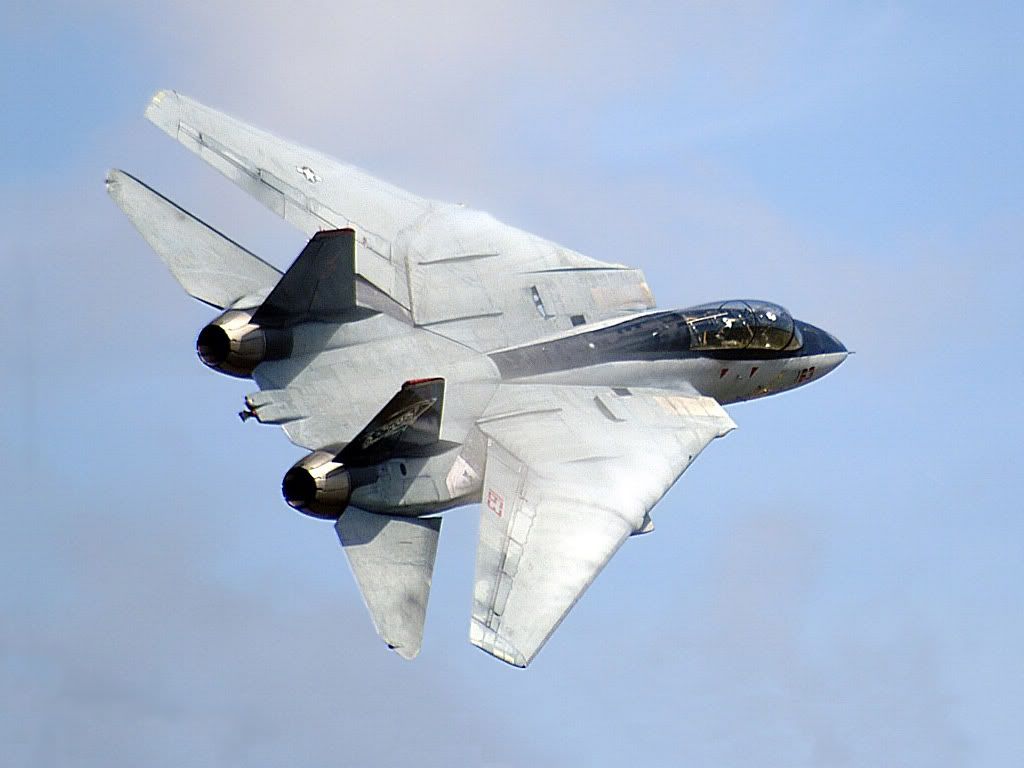 Easily the coolest Tomcat paint job, possibly one of the coolest paint jobs on a military jet period: 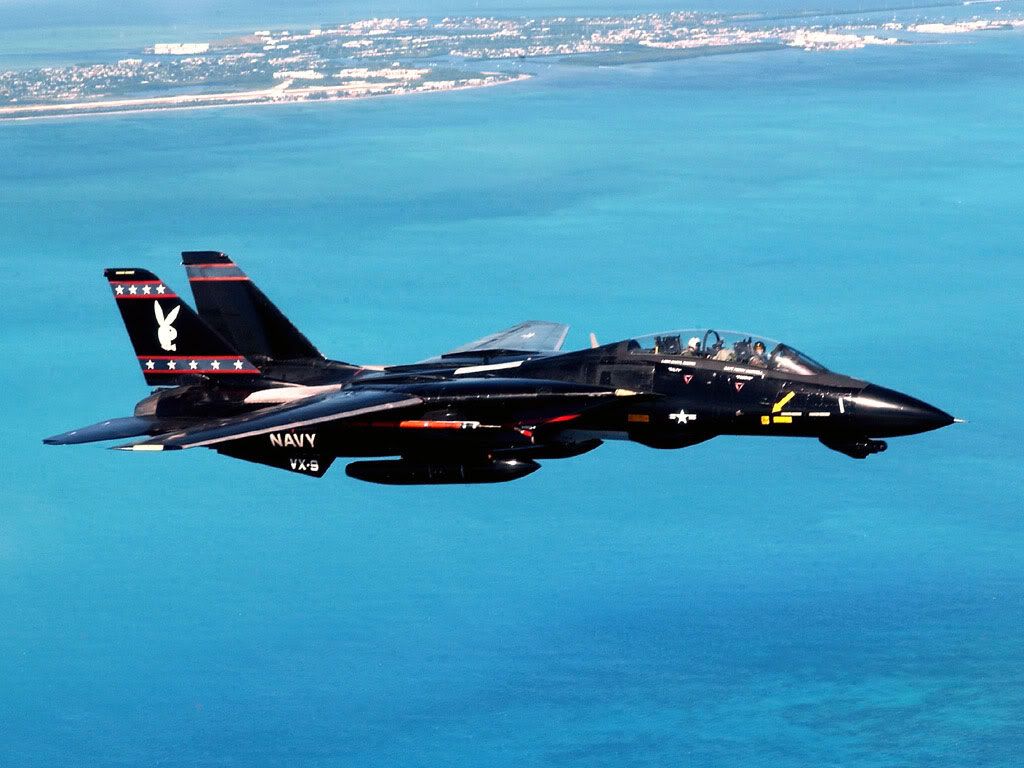 Second coolest Tomcat paint job: 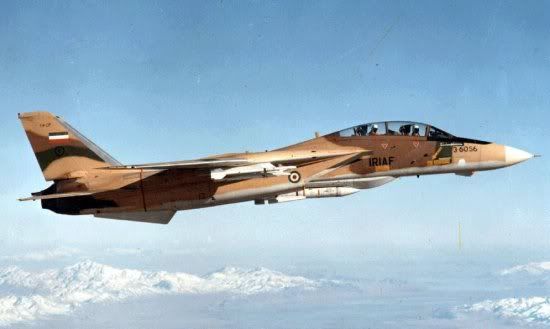 Loaded for bear, ready to take on some Backfires: 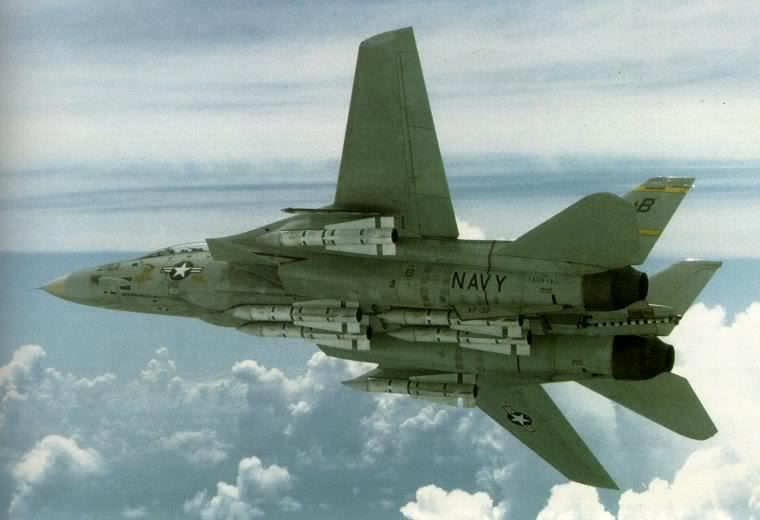 Bombcat: 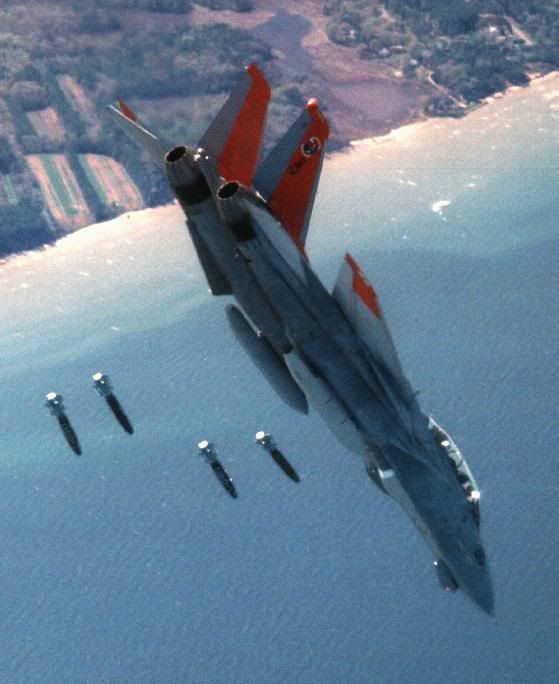 Riding off into the sunset  : :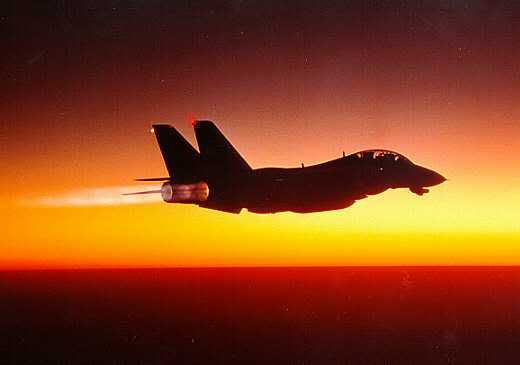 Time for some Euro-love: 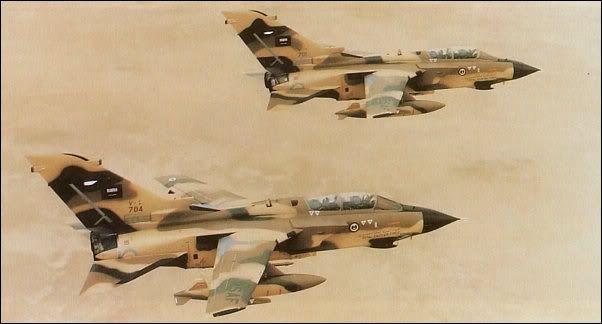  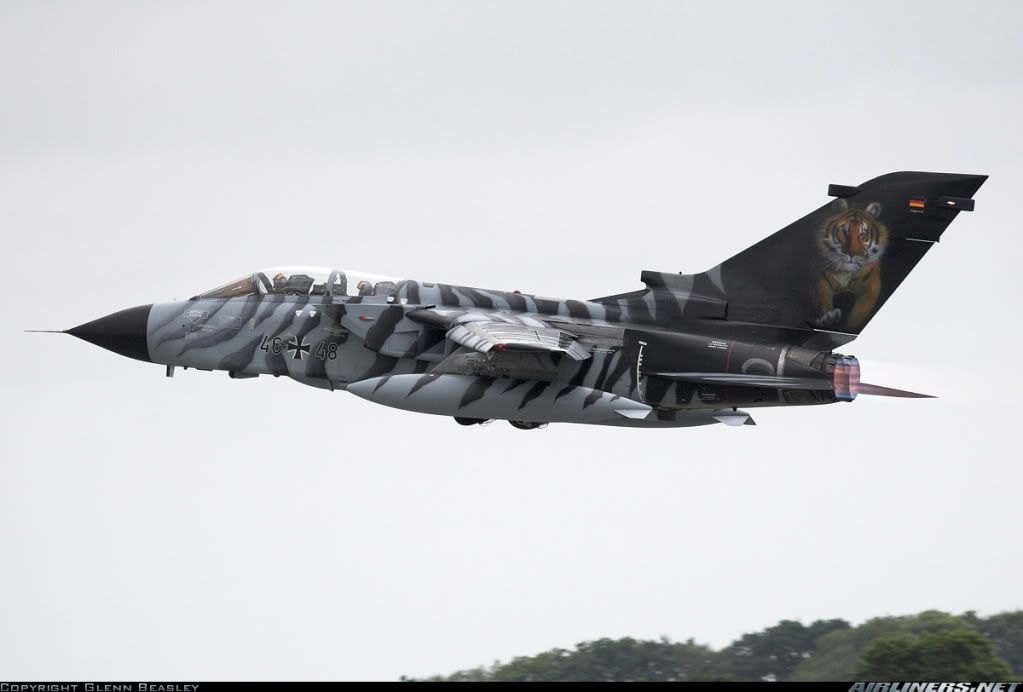 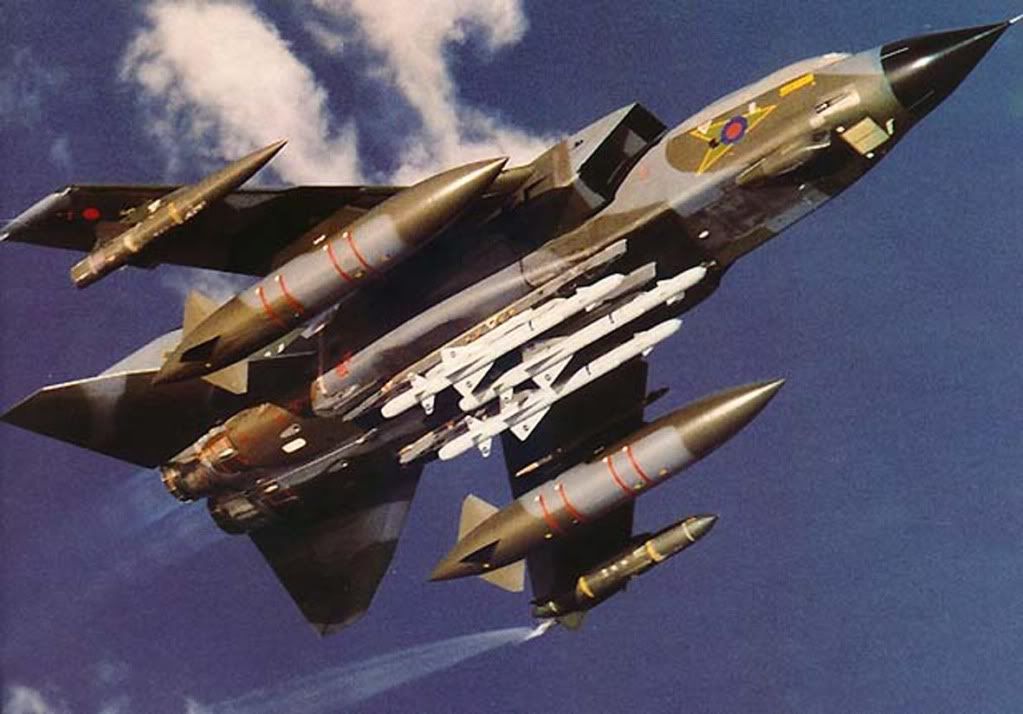 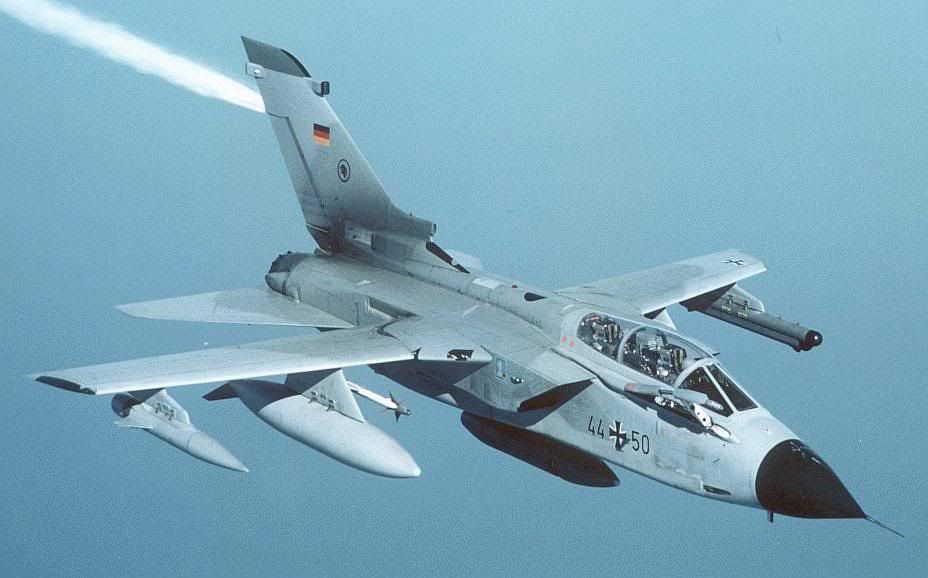 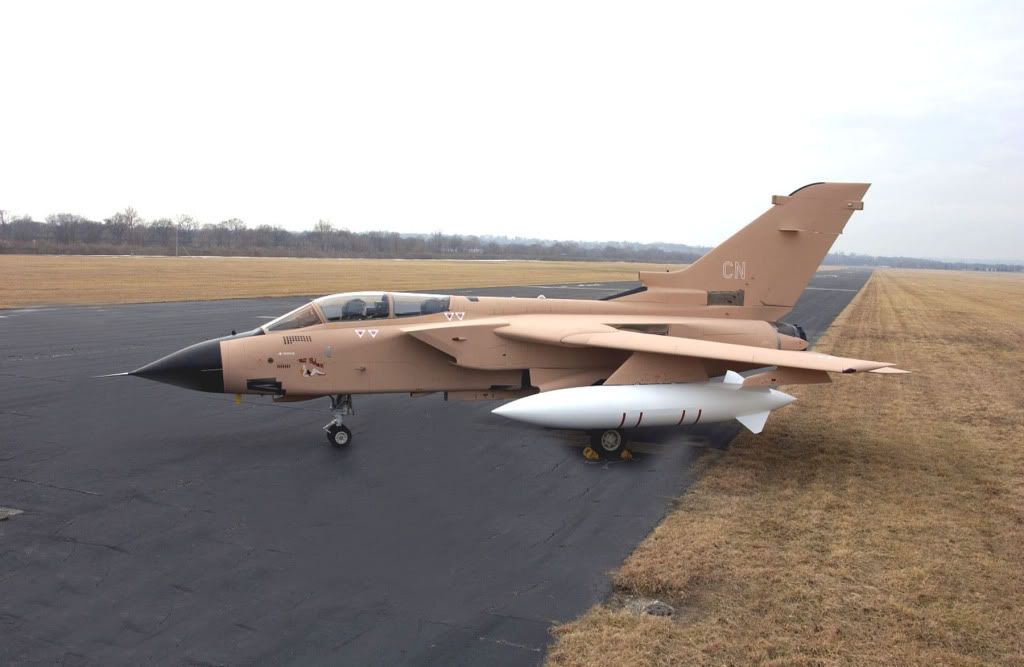 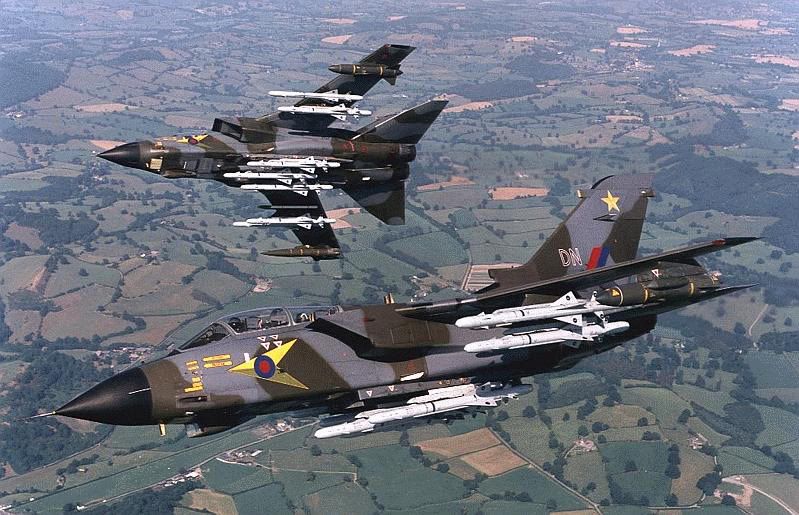 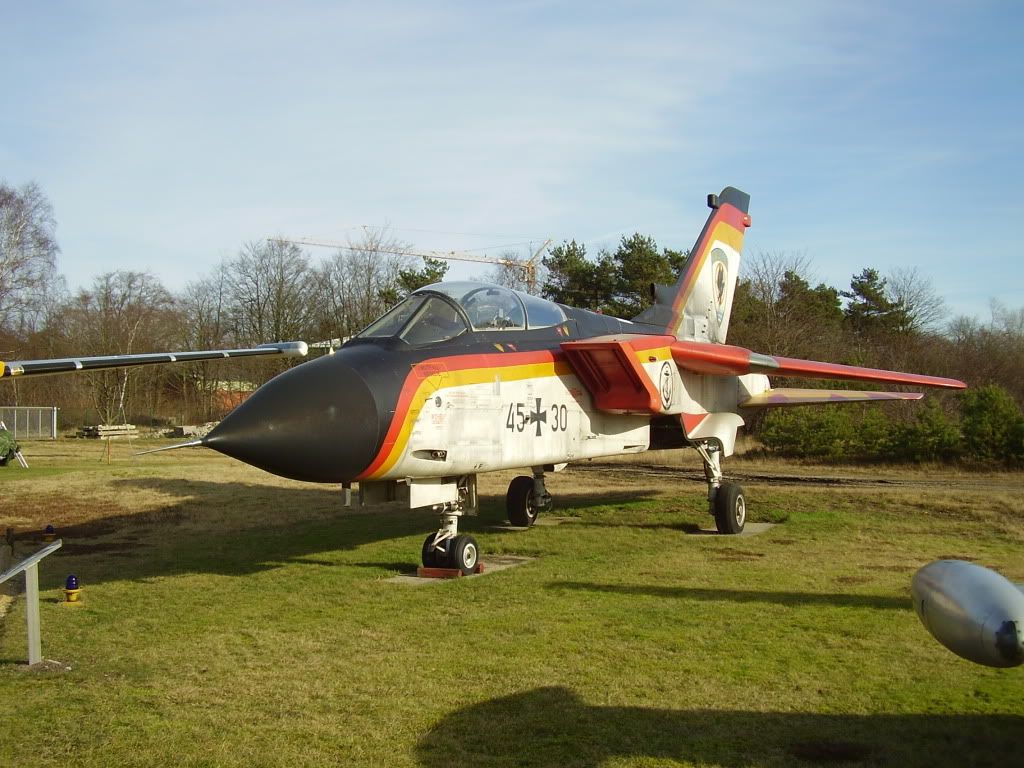 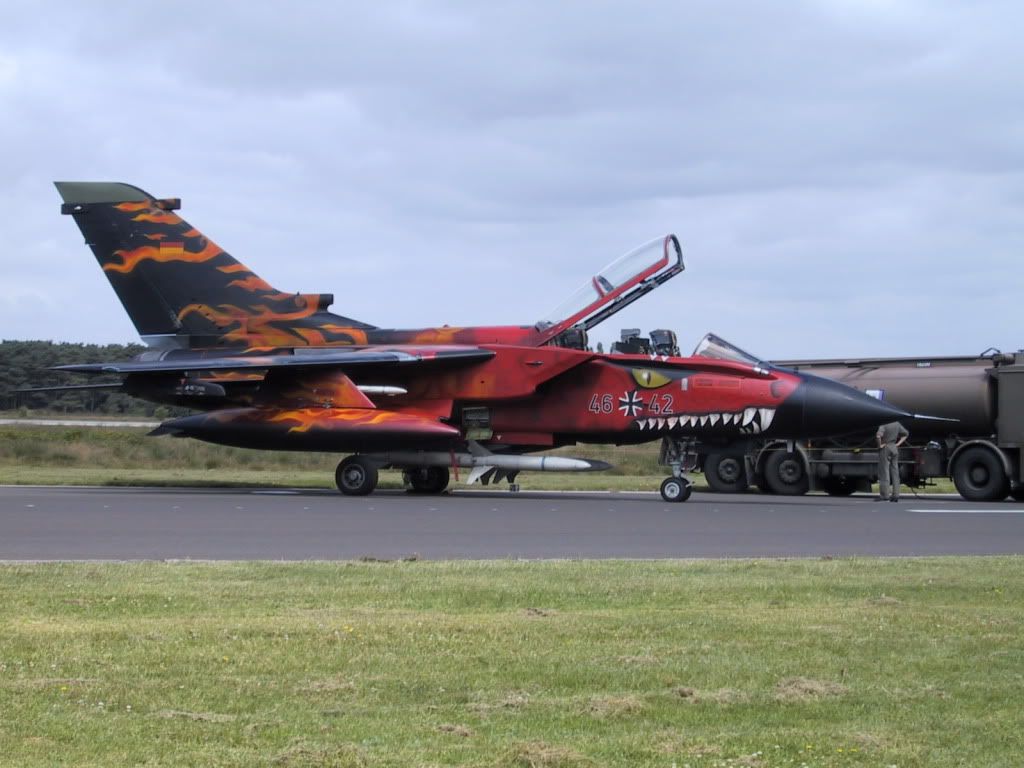 Enjoy.
|
|
|
|
Alaan posted:There is something to be said for hugging the ground. The only kill a Vark has is making the guy follow them plow into a hill. Spark 'Vark!  It was an EF-111 jamming aircraft that got the kill...an Iraqi Mirage F1 following too closely flew into the ground. Happened on the first fixed wing airstrike of the war.
|
|
|
|
Cyrano4747 posted:From what I remember hearing back when the Harrier carriers got the axe in the last budget cut, the Brits are talking about "sharing" a boat with the French for the purpose of keeping a core cadre of the whole laundry list of support staff, boat crews, flight deck, etc. at least somewhat together for when the time comes to train new guys up on new boats. Cyrano, as usual, steals my thunder. The Brits are indeed talking about sharing a carrier with the French as part of the massive defense sharing/exchange/dare I say, "special relationship" dealio they signed a few months ago. This was (arguably) a major driver in the UK decision to forgo procuring the STOVL -B model JSF in favor of the CATOBAR -C model, a decision that was released at the same time as the U.K.France agreement. The idea being that since France currently operates a CATOBAR carrier the U.K. can use it as Cyrano said to maintain a cadre of folks that know how to do naval aviation. Putting that on ice for a decade, not to mention reconstituting it as a CATOBAR when it was STOVL before would be extremely dicey, to say the last. However, as you point out, sharing an instrument of national power like a carrier is a considerable leap beyond doing a joint procurement program or doing extensive professional personnel exchanges...now you're moving beyond the strictly military domain and moving into the political. It will be interesting to see how it works out. Sunday Punch posted:Emirati F-16Es (and F) Do you see that USAF?? Do you see?? THAT is what you should be buying in the interim/instead of JSFs. At the very least pull a Navy (they did this with Super Hornets) and buy some to a) keep the production line open b) provide replacement for the REALLY old aircraft in your fleet (legacy -C/-D Hornets in the case of the Navy, Block 30/32 and 40/42 Vipers in the case of the USAF). Even if you do endup with JSFs you've got some pretty sweet fighters on the cheap, and let's be honest, there's a lot we need tacair to be able to do that doesn't require stealth. If the JSF program goes completely off the rails, you have a viable option B for your tacair replacement needs instead of being forced to choose between an overbudget underperforming domestic program on the one hand (looking at you fatty) and an outstanding underbudget overperforming foreign program on the other (Gripen is the best deal on the international fighter market, bar none).
|
|
|
|
Mr Crustacean posted:It's ok, I'm glad to let the yanks pay for planes while we have the NHS Vincent Van Goatse posted:I'm not iyaayas01, but I'm fairly familiar with the facts of the case since I'm friends with one of Britain's top defense analysts/naval historians (not bragging, it comes from working on a Ph.D in a small field). Pretty much this, although if (and that's a big if) the "carrier sharing" agreement with the French pans out they will hopefully avoid some of the growing pains with restarting operating carriers after a decade while shifting from STOVL to CATOBAR to boot...but they'll only avoid some. The growing pains will be there, and that really brings me to my ultimate point: the UK needs to decide what it wants to have a military for and to fund it to that level. If it wants to maintain it's current structure and international presence, fine. If it wants to sacrifice its global mobility and maritime presence somewhat to provide a land army to NATO/EUFOR (like Germany) fine. If it wants to go in the opposite direction and increase its mobility forces (airlift and sealift along with light infantry) at the expense of heavier ground forces and some navy firepower (like Canada, Leopards notwithstanding), fine. If it wants to cut deeper and maintain a force more like the Danes, with a small well trained mostly lightweight army, small but broadly equipped air force, and a coastal navy, fine. Hell, if they want to go full blown Belgium and just have a few F-16s and infantry companies to look pretty and go play with NATO every once in a while, fine. But make up your mind and fund appropriately. What they are doing is worse than making a decision to curtail the military and fund it accordingly, because they are a) maintaining a hollow force, which will result in it being called upon and failing, and b) wasting money that by halfassing it. Attempting to cut a budget while not cutting responsibilities (in other words, cutting across the board) leads to a worse drop in military readiness than if you make changes in the responsibilities and cut accordingly. It sounds intuitive, but you'd be surprised the number of defense ministers who think they can change that hard fact. You guys are actually serving as a really good object lesson for the U.S...if we aren't careful, our military will be the bigger version of what yours is now in about 10-15 years. You can see this in Gates's comments a few days ago at West Point...the Army is going to be hard pressed to keep the bulk of their heavy mechanized units around. In an ideal defense world, you'd want to have them, but we aren't in an ideal world and the fact of the matter is we're a helluva lot more likely to need our maritime forces (navy and air) than we are heavy armor. The biggest reason of course is that unless you're talking about a very few specialized circumstances (the Fulda Gap, maybe the DMZ in Korea) heavy armor is not a deterrent force. It is a nation conquering force. Naval and (to a slightly lesser extent, admittedly) air forces on the other hand are much more of a deterrent force able to provide security/keep the peace. Anyway, I've gone on for long enough...to answer your question, there was no right choice for the U.K. on their current path. Any one would have lead to severe issues. However, in my humble opinion, they should have made the decision to concentrate their power in the RN and a small but well equipped/highly trained light infantry reaction force along with a bit of armor to contribute to any NATO/EUFOR type contingency quick reaction force. This would mean scaling back the RAF drastically to probably only being some strategic mobility folks (C-17s, C-130s, and a couple associated tankers), a squadron or two of Eurofighters for air defense, and maybe a couple of enablers like E-3s or ISR assets if you can justify the cost. Can any land based strike asset completely and concentrate striking air power in the RN's carriers; also, get some frigates and destroyers that aren't horribly overpriced and so gargantuan you can only afford a few of them, although I suspect that Vincent can speak better to the naval piece than I can.
|
|
|
|
Vincent Van Goatse posted:EDIT: Beat me to it. Such a terrible, terrible idea. slidebite posted:It just dawned on me I had this ashtray. Totally forgot where I picked it up but I got it several years ago. Obviously made during the original B1 program.. so mid 70s I guess? B-1 electronic countermeasures: the world's first self jamming aircraft! For those that don't get the joke, early versions of the Bone's AN/ALQ-161 defensive electronics suite had some teething...issues, and would jam transmissions from the aircraft that should have been let through, in effect jamming itself. slidebite posted:Cool photo, but it lost some of its "coolness" with me when I saw that the artist used the exact same background on pretty much every single jet imaginable. I actually thought I saw it with an Arrow, and in my search to find the print I found something by order of magnitude cooler. Holy poo poo, that pictures owns. Also, Beavers and Otters and Twin Otters own. Actually, so do Caribous and Buffaloes and pretty much anything de Havilland Canada manufactured. daskrolator posted:Unfortunately the USAF is going the route of phased F-16 SLEP to reduce the fighter gap between F-35A IOC and F-16 retirement. I say it's unfortunate because I think it'll cost them more money than they realize to SLEP these old F-16 a/c than it would be to buy new F-16s. Yeah, that's the really frustrating part. I get SLEPing the limited number of F-15Cs to the "Golden Eagle" standard, because there isn't really a ready supplement out there (F-22s don't play and the Silent Eagle concept, while cool, is really more to fill the Strike Eagle role, not the strictly air to air role the Charlie fills). But spending oodles of money to SLEP the Vipers when you could spend just a bit more (or maybe even the same amount depending on how much the SLEP ends up costing) to purchase vastly upgraded NEW MANUFACTURE aircraft of the EXACT SAME TYPE just blows my mind. Whatever, in a decade or so we'll have one squadron of F-22s from the tail end of the production line, a couple squadrons of JSFs, and a few squadrons of ancient Strike Eagles and Hawgs soldiering on and we'll look back at today as the "good ol' days" just like folks today look back at the '80s. That was about half sarcastic bitterness and half somewhat serious prediction.
|
|
|
|
daskrolator posted:But hey, at least you'll have a Next Generation Bomber in the mid 2020 timeframe! Okay, so we'll have like half a squadron of those to replace all the B-1s, the B-2s will still be around and of course we'll have a couple squadrons of elderly BUFFs tottering around the skies, refueled by KC-135s that are as ancient as they are because the KC-X program hit a few unexpected snags. America's Air Force: No one comes close (because they can't find us since we only have 50 aircraft). slidebite posted:
Yeah, I had never heard of that completely harebrained idea and I'm pretty familiar with harebrained aviation ideas. ThisIsJohnWayne posted:here is something that caught my eye: I had not heard of that Soviet program before...interesting stuff. As for U.S. movable guns/turrets on fighter aircraft, the only one I am aware of is the WWII era P-61 Black Widow night fighter which featured four .50 machine guns in a turret on the top of the aircraft. The F-89 interceptor (the jet powered design that was supposed to replace the P-61) was supposed to have a nose mounted turret with 4 20mm cannons, but this was removed when development proved too difficult. As for why it why it wasn't further developed, I would think such a design would prove unfeasible at the speed jet fighters conduct within visual range combat. You would need a serious degree of automation to make the design work.
|
|
|
|
daskrolator posted:Too many unknown requirements as well. We'll see! You mean the unmanned manned nuclear capable non-nuclear bomber that will be F-111 sized but maybe actually be closer to the B-2 and will be 100% strike but will also have ISR capabilities? Nah, the requirements are all hammered out with that one.  To be fair, there has been some public statements that indicate they've started to head a direction with it, but I'll eat my shirt if at least half of those don't change 180 degrees between now and the actual "choose a manufacturer" stage.
|
|
|
|
McNally posted:I remember reading in Bud Anderson's book that he was part of an experiment with "parasite" fighters. Some engineer figured out that an aircraft with free-floating wing panels ended up being more fuel efficient (somehow) and subsequent testing revealed that hooking up two fighters onto the wingtips of a larger aircraft (and then having them shut down their engines) resulted in all three aircraft flying along and the mothership ending up using less fuel than it would have on its own. Too lazy to pull up a picture on this lovely Army LSA connection, but look up the XF-85 Goblin. It was designed to operate from the gargantuan B-36 bomber. Basically the early USAF (USAAF when the proposal first dropped) designed the B-36 to be able to bomb Germany from the continental US during WWII. This meant after the war they had a huge (but relatively slow) bomber that had a very long range. Unfortunately, its slow speed meant it couldn't be expected to penetrate unescorted but its very long range made escort fighters unfeasible. The solution was to rig up a mini jet fighter that would fit into one of the bomb bays and be mounted on a trapeze. The fighter would takeoff and land in the bomb bay of the bomber, only launching during flight to fight off enemy fighters. The project was dropped after there were difficulties hooking up to the bomber and longer range jet powered escorts were developed to fill the role. Also, the fighter's mediocre performance didn't help things. There were only two prototypes built: one is on display at Wright-Pat at the National Museum of the USAF, the other is at the SAC Museum outside of Omaha. I've been to the SAC Museum numerous times, and the Goblin really is a goofy looking aircraft...it's basically a flying egg. To tie it in with this post and the one after it, FICON was developed as an alternative to this program after it was canceled.
|
|
|
|
daskrolator posted:I heard Major general David Scott, who establishes policy for operational capabilities-based requirements for USAF, speak last week about it. He didnt say much. He talked about it being optionally manned, a ballpark # of a/c, and it being a "system of systems." Oh and he wants it ALCM capable, and affordable. Let the shaping begin. Wait, I hope he means "ALCM" in a generic way, not specific to the AGM-86, because the -86s are gonna be out of service by around 2020, so the chances of them being utilized by this new bomber are...slim. But we're already in the process of getting rid of the ACM, and there's not a new nuclear capable cruise missile on the horizon, and I would hope it'd be able to carry a JASSM seeing as how it's small, and that's the only other cruise missile I can think of, so I really have no idea what he was talking about.
|
|
|
|
Cyrano4747 posted:Wouldn't mounting external stores on it like that effectively gently caress its low-profile radar signature straight to hell, though? I mean, what's the point in having a next-gen stealth fighter if you're just going to load a bunch of last-gen weapons on hardpoints on the outside and gently caress up its radar profile? The F-22 currently regularly carries external fuel tanks...since it was (originally, in the long long ago, the before time) designed for combat over Western Europe against the godless Commie hordes, range wasn't really taken into account when designing the aircraft. The general order of priority was LO/"stealth" (I hate using "stealth"), then performance, then weapons payload (compare the Raptor's missile capacity to the Flanker's...you'll see the difference in emphasis), and then fuel capacity (again, compare the Raptor to the Flanker). What this means in a mission area like doing intercepts over the Bering Strait or operating out of Kadena/Andersen over (insert Asian regional hotspot here) is that it is incredibly short legged. The general idea is that they carry the tanks for as long as possible and then punch them and the pylons when they need to regain the LO signature before entering a hostile zone. Additionally, the fact that carrying external tanks completely fucks with the LO signature could be a good thing in certain situations. The Raptor is a "kick in the door" aircraft where it will pretty much only be utilized in actual combat on the first couple of days of a war, to take out the bad guy's air force and to help take down his IADS...we don't fly B-2s over Afghanistan or Iraq today, we won't be flying the Raptor much once we rule the skies over the bad guy's airspace. This means that non-LO external carriage of stores is pretty much a no go for the Raptor, since it doesn't line up with its mission set. However, since the F-35 is supposed to be a replacement for (among other aircraft) the F-16s and legacy F/A-18s, it's going to be flying well after the initial phases of the war...i.e., where LO isn't as big of a deal but combat persistence might be. So the F-35 is designed to be able to carry a considerable amount of external stores in a non-stealthy manner, since it can only currently carry 2x2,000 lbs Mk 84 bombs internally....which is the exact same amount as the Raptor (although the Raptor is limited to 1,000 lbs Mk 83s due to the shape/size of its main weapons bay). Not much for combat persistence, especially in a CAS situation where you typically need a large number of less powerful bombs (250-500 lbs range vs 1,000-2,000 lbs range). Anyway, that last bit was just to point out that with the F-35 there is actually a real reason for external carriage of stores even though it is designed to have a low LO signature...although whether this particular "one size fits all" approach to aircraft design is the best is an argument best left for another day. pkells posted:I know it's from a little while ago, but we have the Emirati Block-60 F-16's stop by our base every month or two. And those things have to be some of the ugliest fighters I've ever seen. That opinion was reinforced when a couple F-22's showed up about a week later to perform some demonstrations. As iyaayas can attest to, the Raptor is a gorgeous aircraft, especially watching it in person. Now I can't say anything about maintaining them, but goddamn is that a pretty airplane. They're ugly looking, but those Block 60s are some sweet aircraft...as I said somewhere previously (maybe in the F-35 GiP thread?) the Block 60s and the Gripen are the best thing going on the international fighter market today regarding bang vs buck, and the F-15K/SG makes a nice compliment for a deep strike fighter. If I was building an air force I'd pick up some Gripens or Block 60 Vipers for the foundation of my fighter force and then snag a few of either of those Mud Hen derivatives for some deep strike ability if I had the money (probably the SG since the -K has a Korean radar that is manufactured locally...nothing against them, I just prefer to do business with as few countries as possible if I'm building a fictional air force.) The Raptor airborne? The Raptor on the ground being fixed? It's really not that bad, but it can be a royal pain in the rear end sometimes...and I don't even deal directly with the jet itself on a regular basis. Armyman25 posted:Lot's of iyaayas postings and back and forth about US strategic doctrine, vis a vi the Marines and their need for organic CAS. Yeah, this thread, that thread, the Ringo thread over here, and the Air Force thread over there are pretty much the only ones I'm actively following while I'm TDY. I kind of gave up on my crusade in that thread to rid the Marines of STOVL because I've only got a limited amount of time each day to post (to be clear, that was my only contention...I have no problem with them operating fixed wing jets for CAS, I just don't agree with the need for STOVL capability.)
|
|
|
|
SyHopeful posted:I have a friend who does MX on the Raptors at Elmendorf. Got a pretty sweet personal tour last time I was up. No pics, of course Where's your friend work? One of the AMUs? I would back this procurement program 100%.
|
|
|
|
wkarma posted:The K is a great jet and the SG even more so with the F-110's, but at this point if you are building a fictional airforce, there's no reason not to go F-15SE. Same front aspect stealth as the export F-35 with the CFT weapons pods, and longer range since the canted tails generate lift. Or you can swap the CFT weapons pods with normal E model CFT's and have full mud hen capability in under 2 hours. Yeah, the SE is a pretty cool concept but I was restricting myself to aircraft that are currently in production...although I'll be shocked if the ROK and Israel don't eventually pick up some. SyHopeful posted:pssshhh last thing a F-22 MX NCO needs is some butterbar snooping around Haha, snooping around? If he works in one of the AMUs I've probably run into him before.
|
|
|
|
McNally posted:My understanding is that the flying boom delivers more fuel, faster. Which is great when, say, the entire Air Force chain of command is basically nothing but heavy bomber guys who think that the B-52 is the most important thing ever. Beat me to it. To expand a bit, the AF experimented with both methods; there are pictures (that I'm too lazy to find on this lovely Army LSA internet connection) of B-29s using the probe and drogue system, but as McNally said the boom delivers a higher volume of fuel at a higher rate (something like 3x the flow rate of a probe and drogue system), which is what you want with large aircraft like bombers. Pretty much every AF fighter through the century series was set up to do probe and drogue with only the heavies using the flying boom. priznat posted:Those nuclear ABMs would have kind of sucked for Canada because they'd probably be detonated overtop of us As others have mentioned, that's a feature, not a bug.
|
|
|
|
Insert name here posted:I like to think that the Air Force brass picked the boom because it makes a better penis surrogate Let's see here...Bury Us Upside Down is a great book about the Misty Fast FACs that flew some of the most dangerous missions of the war (doing FAC duty in F-100s in northern South Vietnam, right near the DMZ where there was a poo poo ton of AAA and quite a few SAMs). Among the notables the flew with this group were Bud Day, Dick Rutan, 2 future USAF Chiefs of Staff (although one was Manly man v-neck undershirt McPeak, so he doesn't really count), 7 future general officers, and a couple astronauts. Bunch of badasses. Here There Are Tigers is written by a guy that spent a year from '68-'69 flying FAC missions into Laos when the U.S. government denied there were U.S. forces operating in the country. I haven't read it but it's supposed to be pretty good.
|
|
|
|
priznat posted:My dad's cousin flew CF-104s and he managed to not crash any of them! (They had about a 50% rate of attrition IIRC) Another interceptor but then also used for strike and recon. Much smaller than the Electric Lightning/Avro/Voodoo though. Couple of fun facts about the F-104: early in the design it was determined that the high t-tail would be too risky to clear with a conventional upward ejecting seat, so they designed it to eject out the bottom. As you might guess, this tends to be detrimental if you are ejecting at low altitude, and after a lot of pilots were killed because of this they retrofitted a new upward ejecting seat that was capable of clearing the t-tail. The pilots also had to wear spurs, which connected to a reel of wire in the ejection seat...when the ejection sequence was initiated, the takeoff reel would pull back, locking the feet into positions to prevent them from flailing and injuring/amputating them. Walking around with spurs only added to the Regarding the loss rate of Canadian Starfighters...yup, they lost right around 50%, a lot of them operating in West Germany. The Luftwaffe lost around 30% of theirs, leading to the dark joke...what's the best way to get an F-104? Buy a plot of land in Germany and wait. The loss rate was probably a combination of the generally lovely Western European weather, lots of low level high speed flying since the -G and CF-104 models were intended to perform as multi-role aircraft with a nuclear strike mission being a large component of that, the adoption of a high speed high altitude interceptor design to be a low level strike aircraft (still not sure what everyone was smoking with that one...although this may have had something to do with it, and in its defense its high wing loading gave it a stable low level ride), and finally the fact that many of the air forces that adopted the Starfighter went from relatively low performance aircraft (think F-86s) straight to the F-104, which is quite a leap in performance. Additionally, that high performance nature also meant the F-104 had some nasty tricks it could spring on you if you weren't careful. Compounding the issue was the fact that the Lockheed C2 upward ejecting seat that replaced the downward ejecting C1 was not zero-zero capable; it required around 100 mph of speed in order to effectively function. This limitation turned a lot of mishaps into fatal ones, and many of the air forces who were operating the type after the USAF eventually replaced the seat with a Martin-Baker that had zero/zero capability. The J-79 engine powering the Starfighter had an interesting quirk...at certain throttle settings it would make an eerie howl due to the interaction of airflow around the exhaust section. Observe: http://www.youtube.com/watch?v=ozIRwMhRVRY&feature=related All J-79s were somewhat capable of doing this, but it was especially pronounced in the F-104 (and the F-4, to a lesser extent.) NosmoKing posted:
Point of order...the YF-12 was actually a development of the A-12 Oxcart program, the predecessor to the SR-71 (although they look similar, the A-12 and SR-71 were two different albeit related aircraft). The YF-12 basically turned into the white side of the Oxcart program...it was publicly announced to provide a plausible excuse when people saw a weird looking aircraft. "Nope, not doing anything weird out in the desert with reconnaissance aircraft or anything, just building a couple of high speed interceptors."
|
|
|
|
NosmoKing posted:But the interceptors had essentially the same performance and design as the recon variant. Pull off the radome and remove the little under engine nacelle fins from the YF-12 and you've pretty much got the SR-71. Oh, I didn't mean to imply that they didn't have similar performance and design, I was just being pedantic about which airframe the YF-12 was developed from...I mean, technically speaking the YF-12 first flew about a year and a half before the SR-71's first flight.
|
|
|
|
Kinda cool video: AirLand Battle in action.
|
|
|
|
theclaw posted:Note: Museum curators hate when people touch old planes or equipment. Thousands of people pawing at them over the years can cause significant damage. The SAC Museum (I refuse to call it by its new name) is an interesting story...I think I've discussed it before in this thread but I'll go through it again since it got brought up. The museum started out as an idea from Curtis LeMay to serve as a memorial to the men and women of SAC and a way of preserving their history. As you probably know, SAC headquarters was located at Offutt AFB in Bellevue, NE, right next to Omaha (and just down I-80 from where the current museum is located at). The museum at that time was located right outside the base, on an extension of the Offutt tarmac. The concrete stretched outside the base perimeter so there was a chain link/barbed wire topped fence cutting down the length of the concrete with a big gate in it. Most of the aircraft were given to the museum in flying condition (several went straight to the museum without any sort of trip to the boneyard) so they just flew to Offutt, taxied over to that part of the ramp, and went through the gate. The aircraft were all stored outside on the tarmac, which as you've both alluded to isn't exactly the best environment for storing historical aircraft in. There was also a small building next to the tarmac that contained most of the non-aircraft exhibits that are in the current museum. It was a small operation and the situation with the aircraft was obviously sub-optimal, but it had one very big thing going for it: a single minded focus to the preservation of SAC history and heritage. There were a couple of old SAC guys that basically just sat around and answered any questions you had...I was pretty young when I went there (8-9 years old) but those guys had some stories. The ONLY thing at the museum was SAC and SAC related aircraft (had a MiG-21 in NVAF colors, for example...Linebacker II and all that). No other extraneous bullshit, the entire focus of the museum was SAC. By the mid '90s, the condition of the aircraft was beginning to seriously deteriorate and since many of them are on load from the National Museum of the USAF at Wright-Pat, they put their foot down and said either you get the aircraft in better conditions or we're taking them back. To be clear, the condition of the aircraft was pretty bad...birds nest's in several of the engines, all sorts of corrosion, paint faded beyond all belief (you can still see the effects of the faded paint, as several of the aircraft have yet to be restored and still have the faded paint from outside storage, most notably the BUFF). To solve this situation, they got a bunch of corporate sponsorship from corporations based in Omaha (UP, Berkshire Hathaway, ConAgra, etc.) along with a really strong grass roots campaign to raise the money to build the new facility out new Ashland (the one you want to). So far, so good. New museum is finished in '98, so they moved all the airplanes out there, including a major effort to truck several of the ones they couldn't disassemble the 30+ miles between sites (had to move power lines, street lights, etc...it was a pretty big deal). I will say there was a certain historical charm to all the old airplanes sitting on an old beat up tarmac (you really got the old warhorse put out to pasture vibe from the whole scene) but the conditions really were unacceptable. In 2001, some genius made the decision to change the name to the "Strategic Air & Space Museum" which "incorporated the Museum's rich past while attempting to reach a larger audience through dynamic programming and exciting educational programs that seek to captivate the interests and imaginations of everyone." What this meant in effect is that instead of focusing on SAC, that stuff stayed static and they turned their focus to children's bullshit. No exaggeration, every. single. one. of the SAC related exhibits in the new museum was there when I first went to the old museum in 1993...Linebacker II, Vietnam POWs, the Doolittle Raid, the last SAC Shield, 8th AF in Europe, all of it. Instead of improving/updating that, they've filled it up with a bunch of stupid crap to make things "more accessible" to children. You want to make things "more accessible" to kids and get their attention? You don't need a bunch of bullshit "ooh, ahh, space and NASA is cool" or the loving pod-racer from Episode I (currently there on a traveling exhibit), you need cool poo poo like the walk throughs they used to do. Back at the old museum they'd have this event once a year in the summer where they'd get a bunch of Air Force active duty guys over from Offutt volunteering and they'd open up most of the old jets so you could crawl around inside. You want to get someone interested in aviation and history? Let them crawl through the tunnel between pressurized compartments in a B-29 or sit in the gunner's seat on a B-36 (both of which I did as a little kid). That's going to get them a helluva lot more interested than some bullshit Star Wars exhibit. I don't think I can sum it up any better than this...while there is a loving Star Wars exhibit inside, the last Looking Glass to fly airborne alert (after 29+ years of continuous 24/7/365 operations) sits outside unrestored in pieces. Sorry for the sperg fest, but the path the museum has taken is a bit of a sore spot with me...it's not that they don't do anything well, because their restoration guys do a really good job and they still do some cool aviation related stuff, like the Nebraska ANG RF-4C they just did a bang up restoration job on, but it just feels like they really lost their focus after the name change.
|
|
|
|
baupdeth posted:Side note, without violating non-disclosure acts, etc, does anyone know if the Soviet's were able/successful at overflights of the Continental US as we were with the U2 and other projects? Not as far as I know. In the early days of the Cold War, the only place they could really even threaten to overfly was Alaska. They didn't have aircraft with the range to hit anywhere else since they didn't have the ring of friendly countries surrounding the area they were trying to penetrate like we did, and presumably one way missions weren't an option for overflights during peacetime. By the time the Bear was developed it was the late '50s and only a few short years later we both pretty much stopped doing stupid things like direct overflights and basing nuclear missiles right off the coast. Adding to the challenge, the length of US airspace that had to be monitored/defended was miniscule compared to that of the Soviet Union...the length of coastline in Alaska is huge compared to that of the lower 48, and we managed to monitor it pretty effectively during the Cold War (and still do today). joat mon posted:You Only Live Twice. Moonraker was the space shuttle one. Marines....IN SPAAAAACCCCCCEEEEEEE! Holy poo poo the Roger Moore James Bond movies suck such huge donkey balls. Chantilly Say posted:Gather 'round while I sing you of Werner von Braun... Didn't Tom Lehrer make an appearance in another thread in TFR recently?
|
|
|
|
MA-Horus posted:(Except armed Predators) Armed Predators were developed and in use operationally prior to the invasion of Iraq.
|
|
|
|

|
| # ¿ May 10, 2024 22:28 |
|
Iron Squid posted:Someone tell me more about the F111. Your wish is my command. The F-111 is an aircraft with an interesting, albeit somewhat controversial and troubled history. It stands as a testament to what happens when the intersection of technology, politics, and policy extends beyond its grasp, but it was also one of (if not THE) finest all weather low level interdictor, seeing service in two wars (Vietnam and Desert Storm) plus a few other assorted actions (El Dorado Canyon and some excitement in the Balkans), with an operational career lasting 43 years. The story starts in the late 1950s...the USAF was facing the spectre of a Soviet air defense system with surface to air missiles and high performance interceptors. In order to ensure that its aircraft were able to deliver their nuclear payloads, it began a move towards low level penetration, both in the strategic SAC forces and the tactical TAC forces. The current TAC fleet of F-100 Super Sabres, F-101 Voodoos, and F-105 Thunderchiefs were capable of low level flight, but were not optimally designed for it. In March of 1958, the USAF released General Operational Requirement (GOR) 169, calling for a Mach 2+ all weather fighter with a 60,000 ft+ ceiling capable of V/STOL. After a few years worth of consideration, the USAF decided that this specification was a tad bit outside the realm of possible technology (you don't say...jesus christ, this thing makes the F-111 as designed look like low risk technology by comparison) and scaled back the requirements, releasing Specific Operational Requirement (SOR) 183 in June of 1960, calling for an aircraft capable of Mach 2.5 performance at high altitude with a Mach 1.2 dash performance at low altitude, with rough/short field performance, able to operate from a 3000 foot runway. It was to have a low level combat radius of 800 miles, including 400 miles on the deck at Mach 1.2. It was to be capable of unrefueled ferry across the Atlantic, plus an internal payload of 1,000 lbs and a total payload between 15,000 and 30,000 lbs. The Air Force thought that variable geometry wings and an advanced turbofan engine would be the only ways to meet the requirements. At the same time, the Navy was developing a two-seat Fleet Air Defense (FAD) fighter to replace the current inventory of F-4 Phantoms and F-8 Crusaders. The idea was to develop an aircraft capable of extended loiter time and able to carry a large number of long range missiles; the aircraft would carry a powerful radar capable of detecting and destroying the Soviet cruise missile carrying bombers that were considered the primary airborne threat to the Navy's carrier battle groups. The reason for these requirements was the high speed of Soviet bombers and cruise missiles...this high speed meant that the carrier would not have enough warning to get aircraft airborne in a timely enough manner to destroy the inbounds; the only solution was to maintain a constant CAP, but the current designs were too short in endurance and would have required a prohibitively large air wing. The proposed design was the Douglas F6D Missileer, a development of the F3D Skyknight. It would carry AAM-N-10 Eagle missiles and be a straight winged firmly subsonic design. It would be powered by 2 Pratt and Whitney TF30 turbofan engines. Unfortunately for the F6D, the Navy recognized the severe limitations of this design; namely, after it launched all its missiles it was a sitting duck with very poor performance and incapable of any sort of dogfighting. Its only recourse would be to return to the carrier and rearm as quickly as possible. The Missileer program was canceled in late 1960. Astute readers will notice similarities in the mission parameters, long range missile design, and engine type between this aircraft and other aircraft that did see production. Those are not coincidences. In January of 1961, Robert S. McNamara became Secretary of Defense. He wasted no time in attempting to make his mark, and within a month of assuming the office he directed the USAF and USN work together and merge their supersonic low level interdictor and subsonic fleet air defense interceptor programs into a joint program, with the added caveat that it be able to provide the Army and Marines with a close air support aircraft (this was before the 1966 Johnson-McConnell Agreement that formally removed most of the Army's fixed wing capability). So to recap, we have a Secretary of Defense who thinks the same airframe can be used to meet three disparate missions: a close air support fighter operating close to the front lines, a long range supersonic interdiction aircraft, and a subsonic fleet defense interceptor capable of long loiter times. Yeah. Fortunately, the services managed to convince McNamara at an early stage that the close air support component was completely unrealistic, and it was dropped. This left the supersonic interdictor and subsonic fleet air defense fighter, which were formally joined in June of 1961 under the "Tactical Fighter Experimental" (TFX) program. Both services worked together to develop an RFP for the new program, but there were considerable differences between the two. In fact, about the only thing they agreed on was that the jet needed to have variable geometry wings. The Navy wanted side by side seating, while the AF wanted tandem. The USN needed a long range search and intercept radar with a radar dish size of 48'' in diameter, while the AF needed a terrain following radar capable of low altitude operations. The Navy wanted a subsonic aircraft capable of long loiter times at medium to high altitudes, while the AF needed supersonic dash performance at low level. McNamara waved away these differences and directed that the services go ahead and release an RFP based largely on the AF's requirements. The Navy raised a flag that an aircraft designed to AF requirements would be unable to meet its requirements; the AF wanted a max gross weight of 75,000 lbs, the Navy had a rather inflexible ceiling of 50,000 lbs (this was due to weight requirements to launch the aircraft using a catapult). The Navy also had a fixed requirement of 56' in length in order for the aircraft to be able to fit on existing carrier elevators. McNamara directed the Navy to accept a gross weight of 55,000 lbs and a 36'' radar dish instead of the requested 48'', and the RFP was released to industry in October of 1961, with proposals received in December from Boeing, General Dynamics, Lockheed, Grumman, McDonnell, Douglas, North American, and Republic. By January both services agreed that none of the proposals were acceptable, but that Boeing's and General Dynamics's warranted further study and development. Throughout the first half of 1962, the contractors continued to submit revised proposals, with the AF eventually settling on Boeing's but the Navy refusing to commit. McNamara had had enough, so he directed a final evaluation be held using a points based system and scoring on the basis of performance, cost, and commonality. Using this framework, by the fall of '62 all parties had agreed on the Boeing proposal. However, McNamara directed that General Dynamics be declared the winner on the basis of its greater commonality; the Boeing design shared less than 50% of its parts between the two main variants. This generated the first major controversy with the program, as Congressional hearings were held but to no avail: McNamara's decision to override the services stood. The two variants used the same structural components, the same P&W TF30-P-1 turbofan engines, the same side by side seating, and the same escape capsule instead of separate ejection seats. The Navy -B variant would carry the Hughes AN/AWG-9 pulse doppler radar and an armament of 6 AIM-54 Phoenix long range air to air missiles (a development of the earlier AAM-N-10 Eagle), while the AF -A variant would carry the General Electric AN/APQ-113 attack radar and the Texas Instruments AN/APQ-110 terrain-following radar and an armament of air-to-ground stores. GD had no experience with carrier based fighters and therefore teamed up with Grumman to develop the -B model. Grumman would also be responsible for the aft fuselage and landing gear of the -A model. Unfortunately, that's all I've got for now...got an early flight. I'll try to update if/when I have time, but I'm going TDY so it might be spotty. If anyone else wants to jump in, feel free.
|
|
|






 artwork:
artwork:






